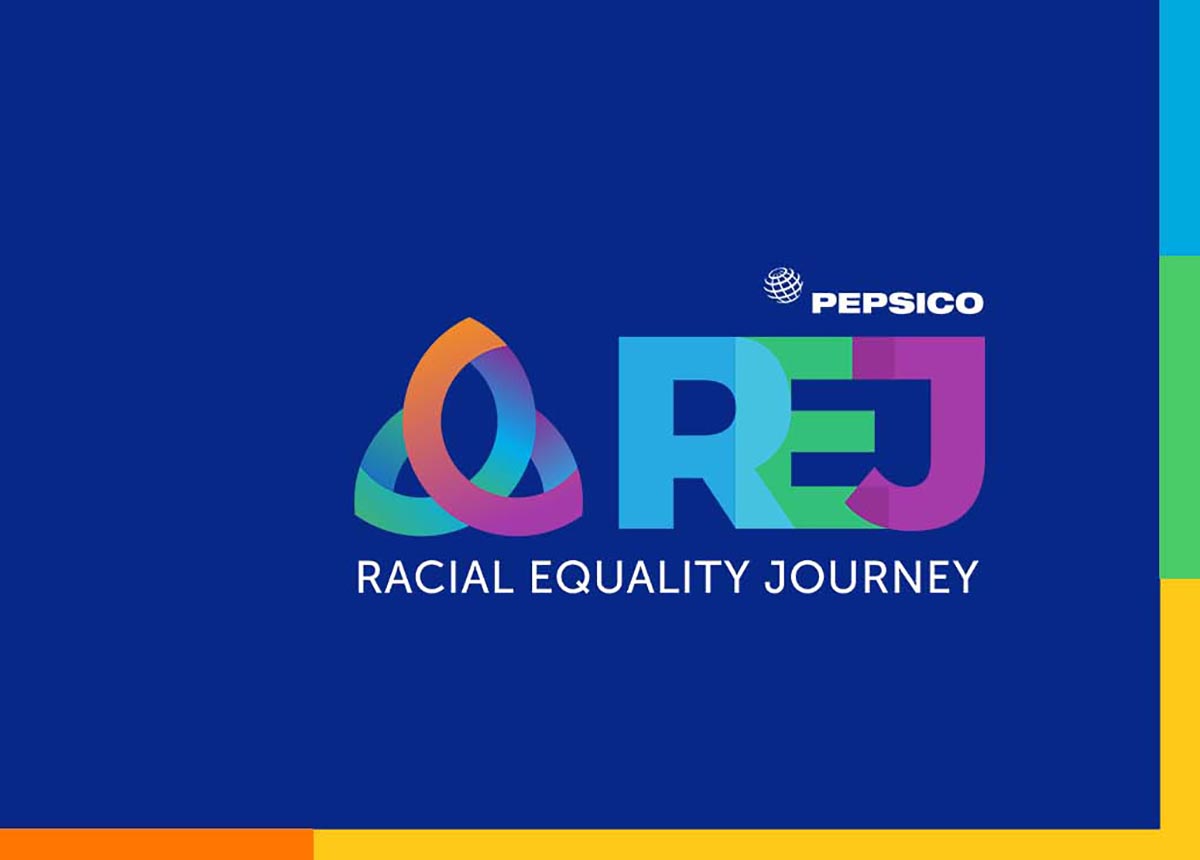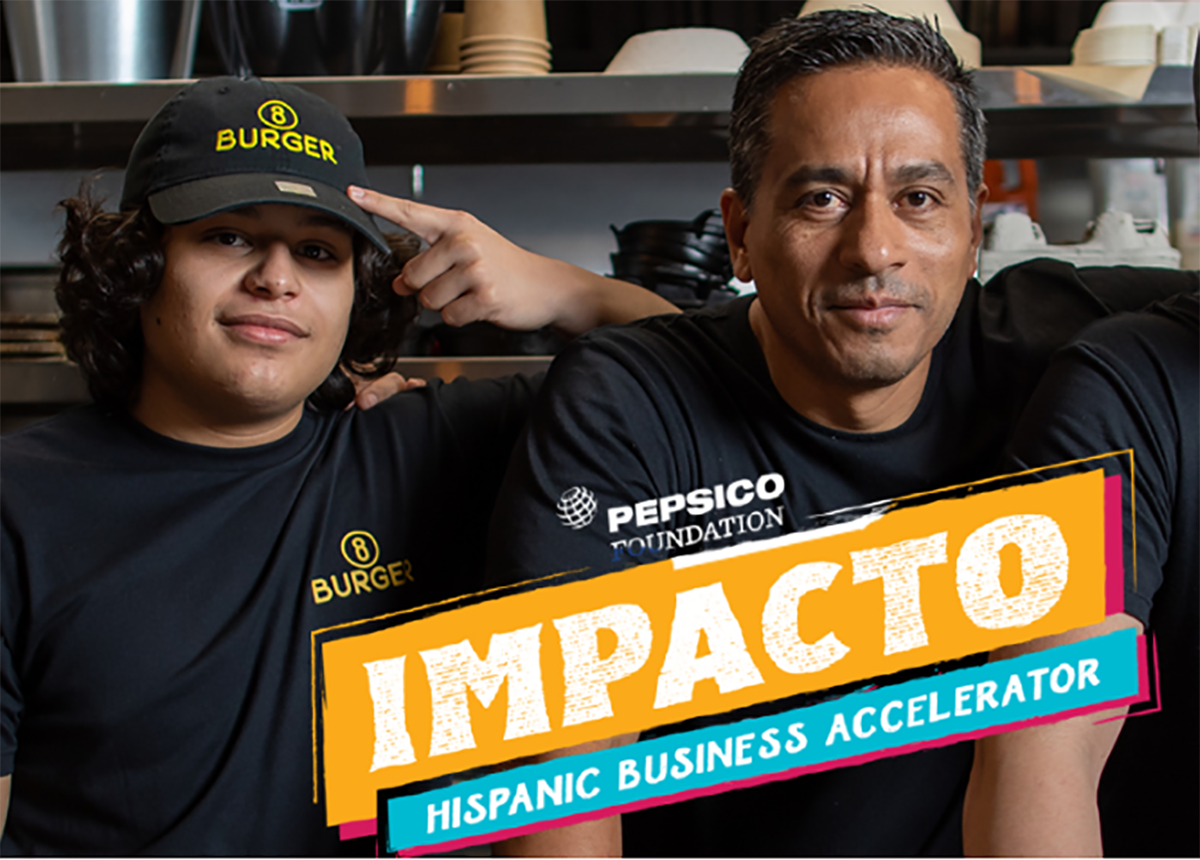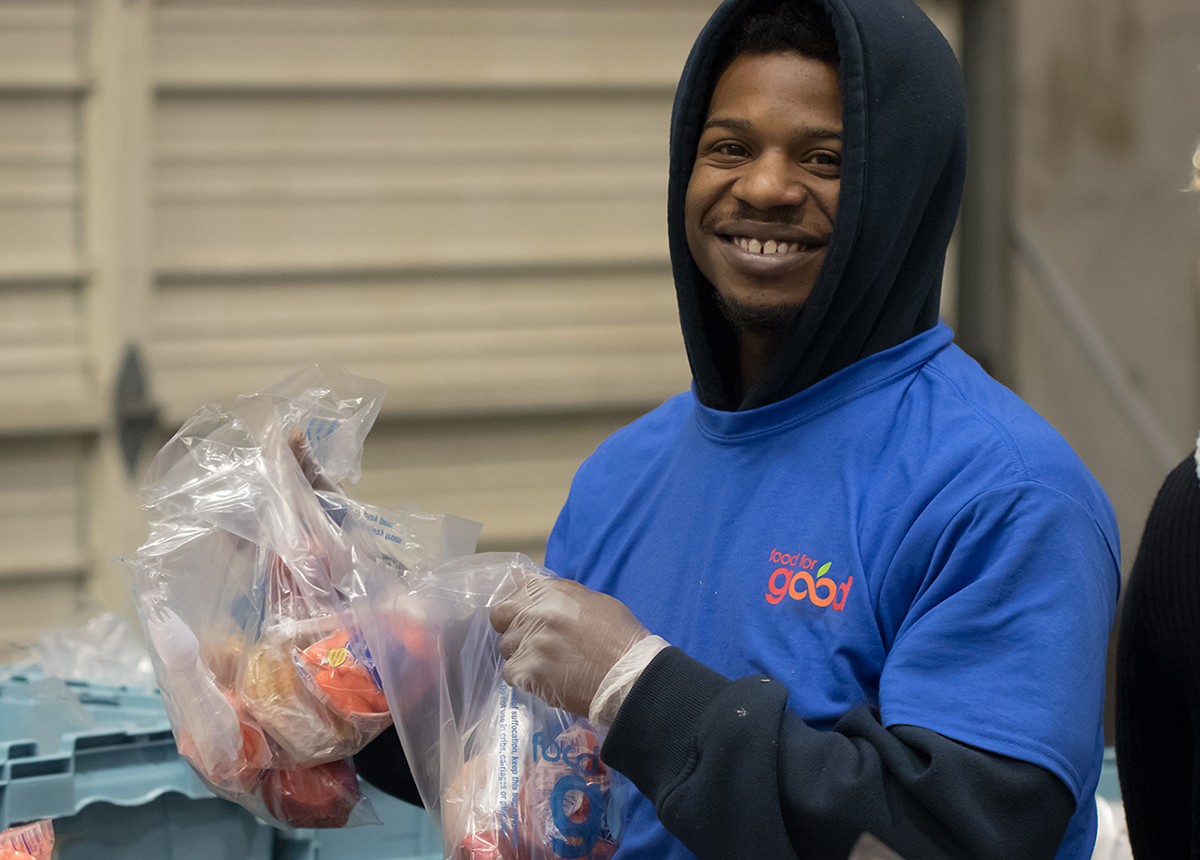A value chain is the full range of activities needed to create a product or service.
Ours begins with the crops grown by our farmers and suppliers, which are made into food and drinks and packaged at our manufacturing facilities, then delivered to stores where they are purchased, consumed and later recycled or collected as waste.
PepsiCo is building a circular and inclusive value chain to accelerate the systemic change needed to address major global challenges.
We’re taking direct action aimed to reduce impacts relating to climate, minimize water use and introduce more sustainable packaging. We are also working to increase racial equality and provide meaningful jobs and opportunities.
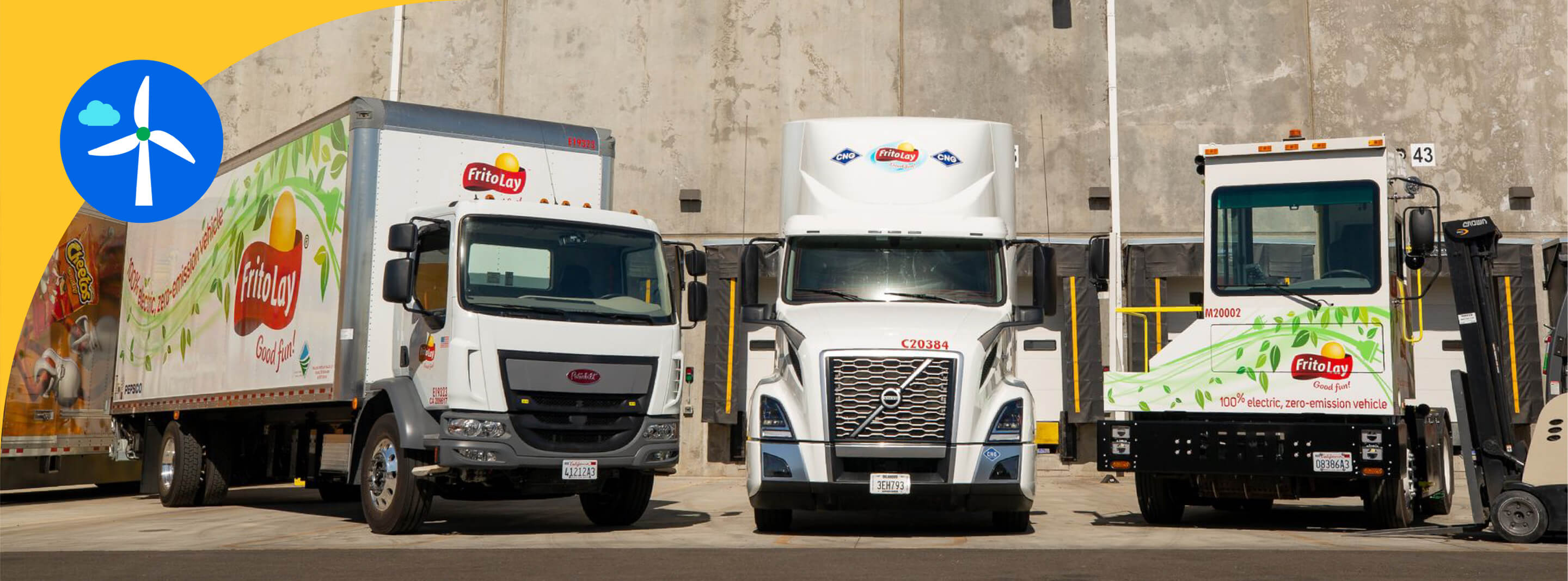
Climate
Climate
Our world is already feeling the effects of climate change and faster, bolder action is needed. Reducing greenhouse gas (GHG) emissions will benefit society and it’s also crucial to the viability of our business, as we are experiencing the impacts of climate change directly within our own value chain.
Urgent action is needed to decouple economic growth from carbon emissions. The increasingly severe impacts of climate change are affecting the quantity and quality of agricultural raw materials for our products, creating weather patterns and events that affect the operation of our facilities and supply chain and limiting the availability and quality of water.
To achieve the level of decarbonization that the world needs to avert the worst impacts of climate change will require action at every level. At PepsiCo, we’re striving to achieve net-zero emissions by 2040, a decade earlier than called for in the Paris Agreement and we’ve set an ambitious interim goal for reducing absolute emissions across our value chain by more than 40% by 2030, including a reduction of 75% in Scope 1 and 2 emissions (2015 baseline). These goals will not only have meaningful impact in themselves, but will also drive greater scale for systems like renewable energy and regenerative agriculture, which must become standard in our industry.
Our climate action strategy
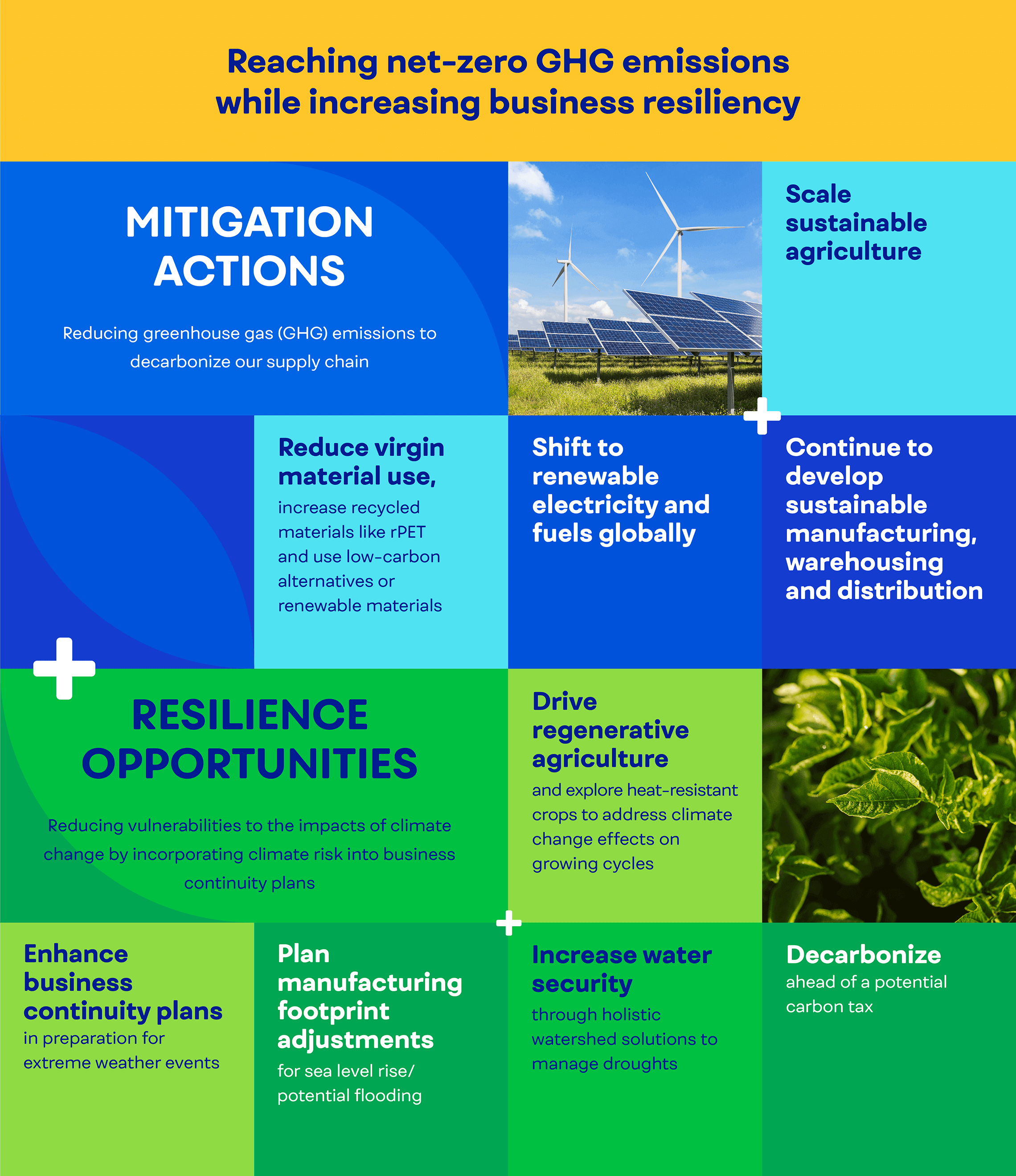
Goals & progress
Achieve net-zero emissions across our value chain by 2040
GHG emissions reduction goal
![Reducing total absolute greenhouse gas (GHG) emissions by more than 40% [footnote 1][footnote 2]](https://usa-pepsicoredesign-global-prod.pepext.com/images/default-source/sustainability/2021-esg-summary/pepsico_esg21_chart_value-chain-climate-goals-and-progress-1.png)
Scope 1 and 2 emissions reduction goal
![Reducing Scope 1 and 2 emissions by 75% [footnote 1][footnote 4]](https://usa-pepsicoredesign-global-prod.pepext.com/images/default-source/sustainability/2021-esg-summary/pepsico_esg21_chart_value-chain-climate-goals-and-progress-2.png)
Scope 3 emissions reduction goal
![Reducing Scope 3 emissions by 40% [footnote 1][footnote 5]](https://usa-pepsicoredesign-global-prod.pepext.com/images/default-source/sustainability/2021-esg-summary/pepsico_esg21_chart_value-chain-climate-goals-and-progress-3.png)
2. Where 2021 actual data was not available, estimated 2021 data was used. Goal timeline extended to 2030. Goal ambition increased from 20% to more than 40% reduction. 2021 Scope 3 progress impacted by increased packaging use, transportation, third-party manufacturing and other purchased goods due to business growth.
3. Results reflect the exclusion of Be & Cheery and certain Scope 3 emissions for other acquisitions where data is not available.
4. Goal timeline extended to 2030. Goal ambition increased from 20% to 75% reduction.
5. Where 2021 actual data was not available, estimated 2021 data was used. Goal timeline extended to 2030. Goal ambition increased from 20% to 40% reduction. 2021 Scope 3 progress impacted by increased packaging use, transportation, third-party manufacturing and other purchased goods due to business growth.
Approach
Our climate action strategy is focused on mitigation to reduce GHG emissions and decarbonize our supply chain, and resilience to reduce the vulnerability of our supply chain to climate change-related impacts.
Informed by science, we target areas where our investments can have the greatest impact, while creating scalable models and partnerships to accelerate progress across the full value chain.
On our journey to achieve our overarching goal of net-zero emissions by 2040, we’re working to reduce absolute GHG emissions by more than 40% across our entire value chain by 2030. Our emissions target aligns to the Business Ambition for 1.5°C pledge and has been approved by the Science Based Targets initiative.
To reach these ambitious goals we're transforming how we operate across our entire value chain.
We’re planning to transition to 100% renewable electricity through a diversified portfolio of options across all our company-owned and controlled operations globally by 2030 and across our entire franchise operations by 2040.
We are investing in zero- and near-zero emission delivery vehicles for our company-owned fleets and partnering with others to support decarbonization of the broader transport industry. We are improving energy-use efficiency and working to scale renewable fuel solutions at our manufacturing facilities.
![~70% of our global electricity needs were met by renewable sources [footnote 1]](https://usa-pepsicoredesign-global-prod.pepext.com/images/default-source/sustainability/2021-esg-summary/pep-pillars-value-chain-climate-stat1.png)
![11th top corporate buyer of clean power in North America [footnote 2]](https://usa-pepsicoredesign-global-prod.pepext.com/images/default-source/sustainability/2021-esg-summary/pep-pillars-value-chain-climate-stat2.png)
2. This metric is ranked by the EPA Green Power Partnership.
PepsiCo is proud to be among the companies that are putting substantial investment behind climate action. We issued a Green Bond in 2019, one of the first food and beverage corporations to do so, and as of the end of 2020, $858 million of the net proceeds had been allocated to investments that can make a lasting impact on our sustainability goals in packaging, decarbonization and water.
We’re working to scale regenerative agriculture practices that reduce emissions and sequester CO2 across the equivalent of our 7 million acre global agricultural footprint, through efforts like our demonstration farm program.
We’re investing in research and development of bio-based materials, increasing recycled content in our packaging (targeting 50% across our plastic packaging by 2030) and working with peers, policymakers and innovators to develop recycling infrastructure, while advocating for smart policies and engaging consumers in our vision that packaging never becomes waste.
These global challenges will require partnership and collaboration among many companies and organizations, as well as international cooperation. We are actively engaged in and seeking out partnerships that help us further our goals.
Explore Climate topics in more depth
PepsiCo's ESG Topics A-Z resource provides detail on strategy, data, policy, progress and more on a wide range of subjects.
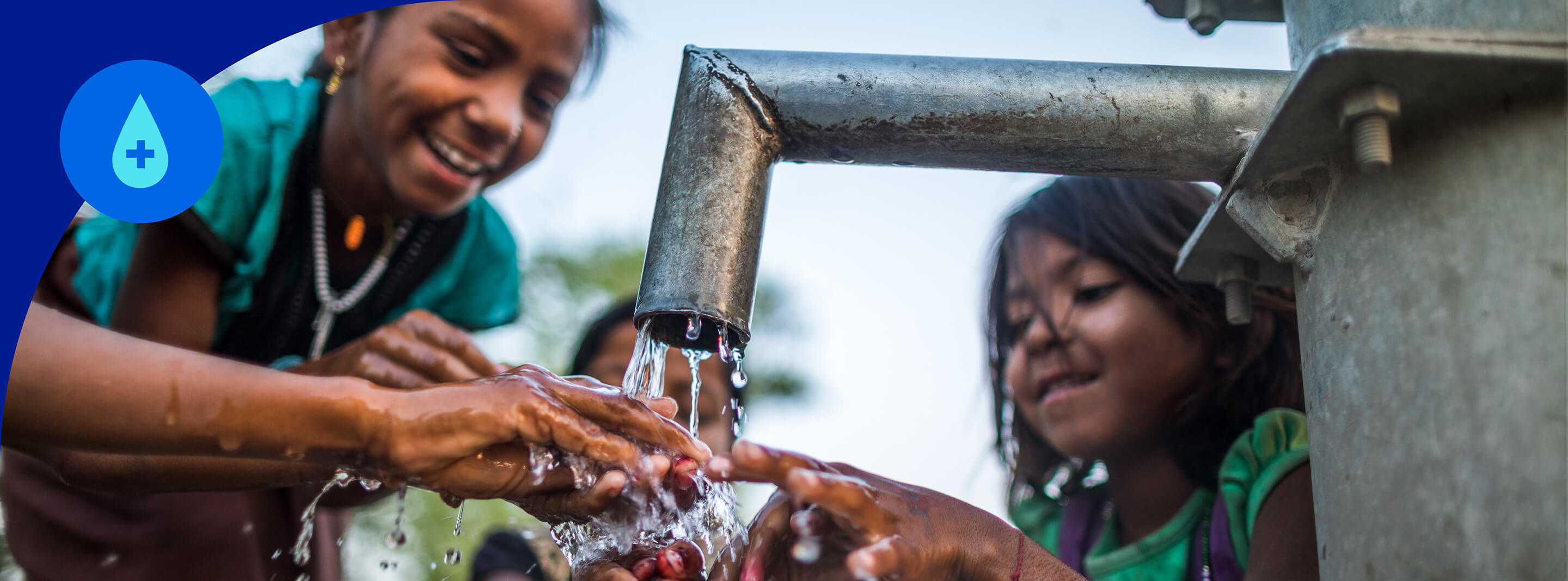
Water
Water
As a beverages and convenient foods company, PepsiCo is acutely aware of the critical role water plays in the food system, and it is our vision that wherever in the world PepsiCo operates, water resources will be in a better state because of our presence.
We were one of the first companies to acknowledge access to clean, safe water as a fundamental human right and essential for health, well-being, dignity and economic mobility. In this era of COVID-19, safe water access is more important than ever.
The PepsiCo Foundation is already more than halfway to our goal of delivering safe water access to 100 million people by 2030.
Our path to net water positive
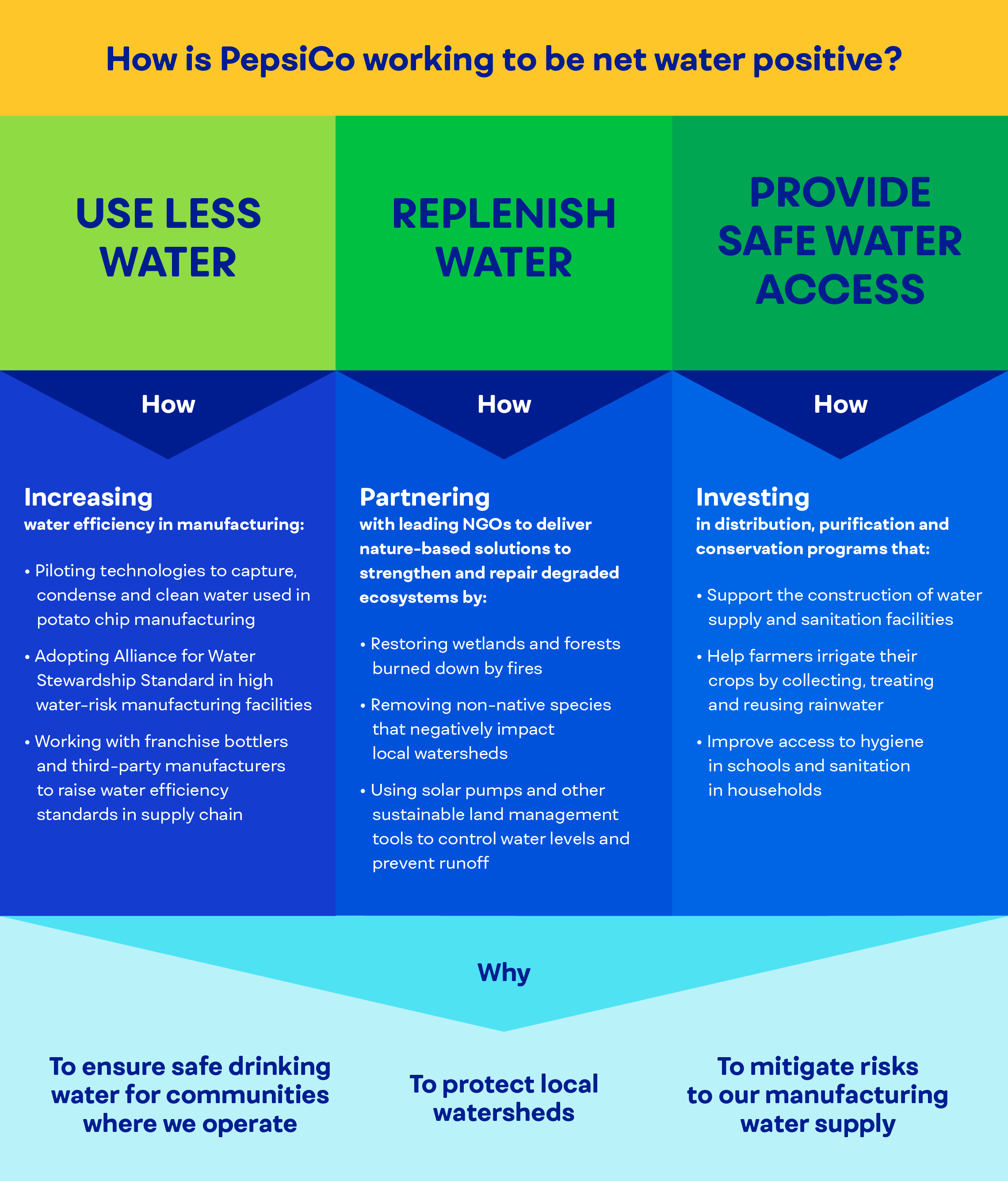
Goals & progress
Operational water-use efficiency goal
![Improve operational water-use efficiency by 25% in high water-risk areas by 2025 [footnote 1], [footnote 2]](https://usa-pepsicoredesign-global-prod.pepext.com/images/default-source/sustainability/2021-esg-summary/pepsico_esg21_chart_value-chain-water-goals-and-progress-1.png)
Net water positive goal
![Ensure net water positive impact by: Best-in-class water-use efficiency in 100% of high water-risk manufacturing sites, and world-class water-use efficiency in all other manufacturing sites, PepsiCo and third-party facilities [footnote 3]](https://usa-pepsicoredesign-global-prod.pepext.com/images/default-source/sustainability/2021-esg-summary/pepsico_esg21_chart_value-chain-water-goals-and-progress-2.png)
Local watershed replenishment goal
![Replenishing back into the local watershed more than 100% of the water we use [footnote 5]](https://usa-pepsicoredesign-global-prod.pepext.com/images/default-source/sustainability/2021-esg-summary/pepsico_esg21_chart_value-chain-water-goals-and-progress-3.png)
Water Stewardship Standard goal
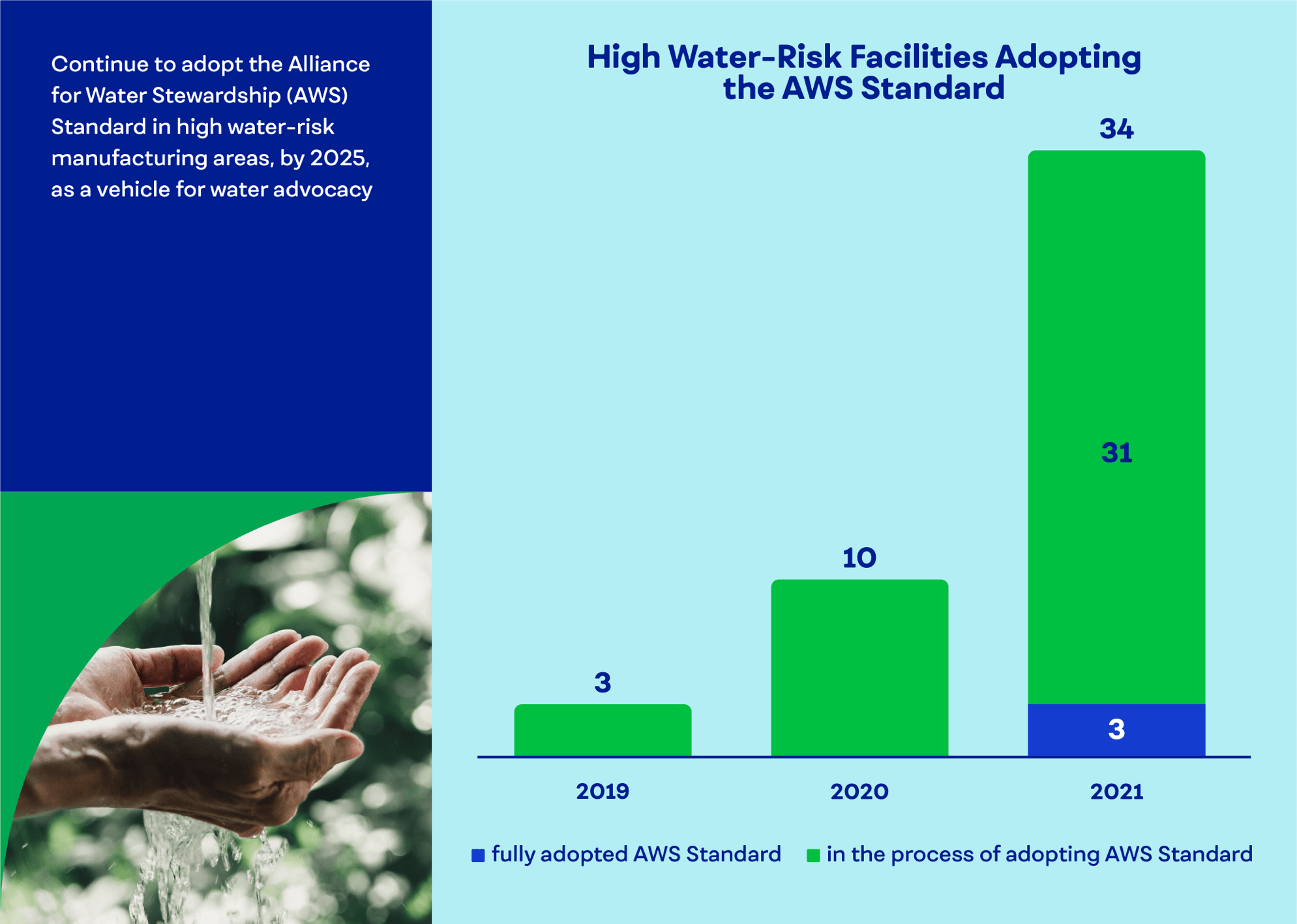
2. Results reflect the exclusion of Be & Cheery.
3. All best-in-class and world-class results for 2021 do not reflect inclusion of third-party facilities
4. Best-in-class water-use efficiency for beverages sites is defined as 1.2 liters/liter of beverage production. Best-in-class water-use efficiency for convenient foods sites is defined as 0.4 liters/kg of convenient foods production. World-class water-use efficiency for beverages sites is defined as 1.4 liters/liter of beverage production. World-class water-use efficiency for convenient foods sites is defined as 4.4 liters/kg of convenient foods production.
5. Results reflect the exclusion of SodaStream and Be & Cheery, and do not reflect inclusion of third-party facilities. Goal ambition expanded to include third-party facilities (100%) and more than 100% for company-owned operations by 2030.
Approach
As one of the first companies of our size to acknowledge water as a human right, we have a vision to become "net water positive." We have adopted an approach to watershed management that includes improving water-use efficiency across our value chain: on farms and in manufacturing facilities; replenishing water in the local watersheds that are most at risk and where we operate; and increasing safe water access for communities that face scarcity.
Our target to become net water positive in 100% of high water-risk company-owned and third-party manufacturing facilities by 2030 means achieving best-in-class water-use efficiency at company-owned facilities in high water-risk areas (a more than 50% reduction in absolute water use against a 2015 baseline), and world-class efficiency at all other manufacturing facilities.
To meet our efficiency goal, we’re expanding our focus from about 100 manufacturing sites to more than 1,000 sites around the world, including 350 sites in high water-risk areas. Achieving our goal will place us among the most water-efficient food or beverage manufacturers in the world. We are also in the process of adopting the Alliance for Water Stewardship Standard at 100% of our company-owned high water-risk manufacturing sites by 2025.
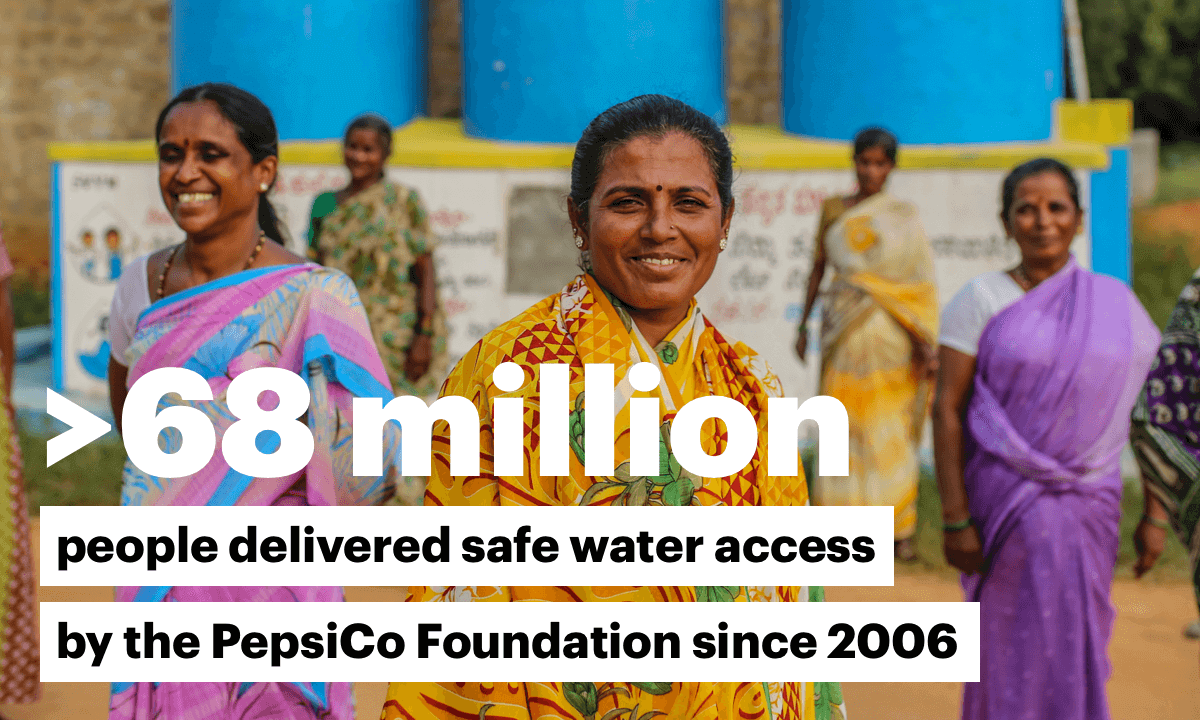
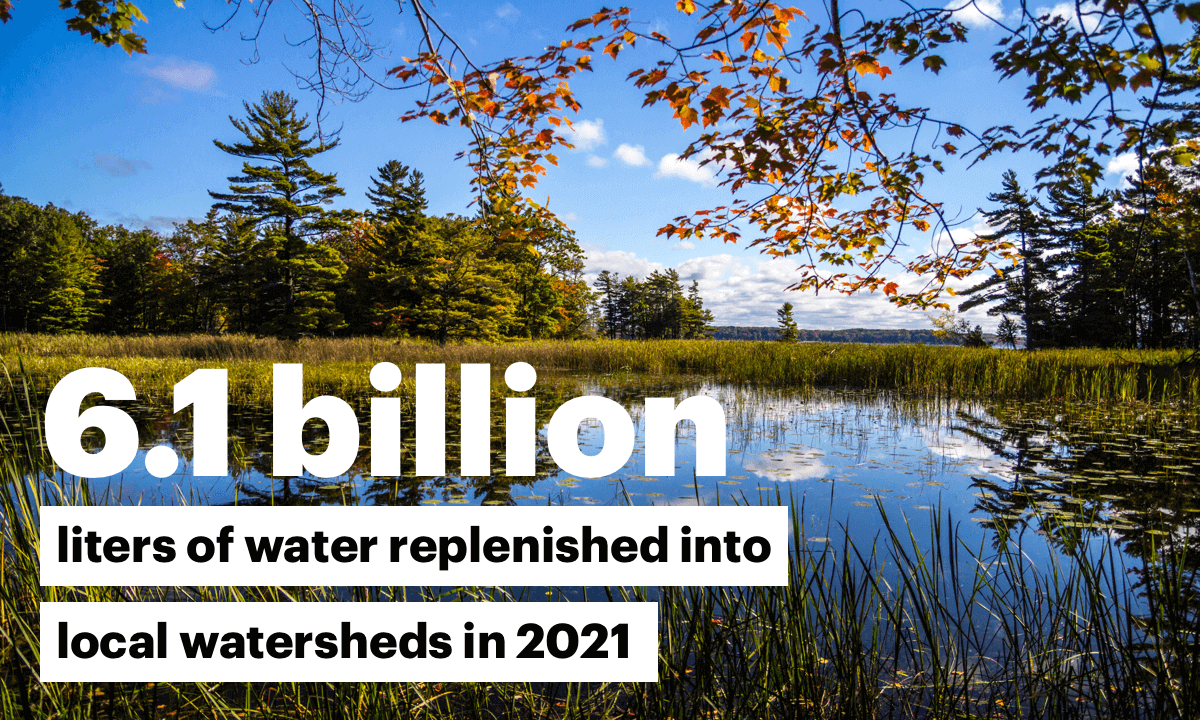
We are piloting innovative manufacturing technologies, including a groundbreaking method to recover more than 50% of the water used in potato chip manufacturing by condensing and treating evaporated steam, effectively capturing and reusing the water contained in the potato that would have otherwise been “lost” as steam. Our pilot testing showed the approach could save approximately 60 million liters of water a year.
To achieve our goal of replenishing more than 100% of the water that we use back into the local watershed by 2030, we’ve established strong partnerships with leading NGOs such as The Nature Conservancy and the World Wildlife Fund (WWF) to deliver nature-based solutions that strengthen and repair degraded ecosystems. Last year alone we replenished more than 6.1 billion liters of water through these projects. We also serve on the corporate advisory group for water for the Science Based Targets Network (SBTN), piloting the draft methodology for setting science-based targets for water.
Explore Water topics in more depth
PepsiCo's ESG Topics A-Z resource provides detail on strategy, data, policy, progress and more on a wide range of subjects.

Packaging
Packaging
PepsiCo envisions a world where packaging never becomes waste.
While packaging is an essential component of our business—making PepsiCo products convenient, more affordable and easy to distribute—we share the concern over the impact of packaging waste. Our broad-based strategy includes reducing the plastic we use, driving recycling and use of recycled materials, and reinventing our packaging to use new renewable materials or drive growth in low- or no-packaging formats.
A circular economy for packaging can help ensure that the valuable materials that are used in packaging are recycled and reused, rather than becoming waste. Using renewable or recycled materials also reduces the GHG impact of our packaging, supporting our emissions reduction goals.
Our sustainable packaging vision
How we're working toward our vision of a world where packaging never becomes waste
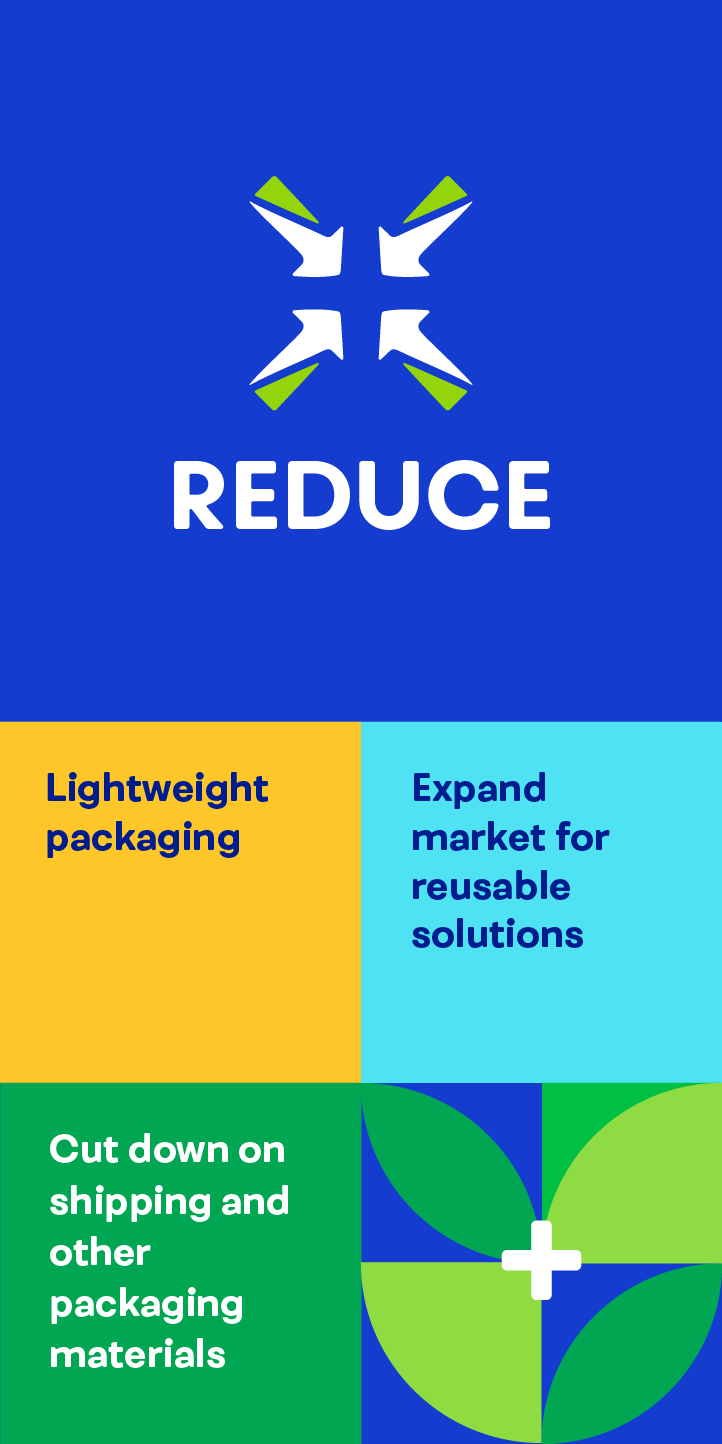
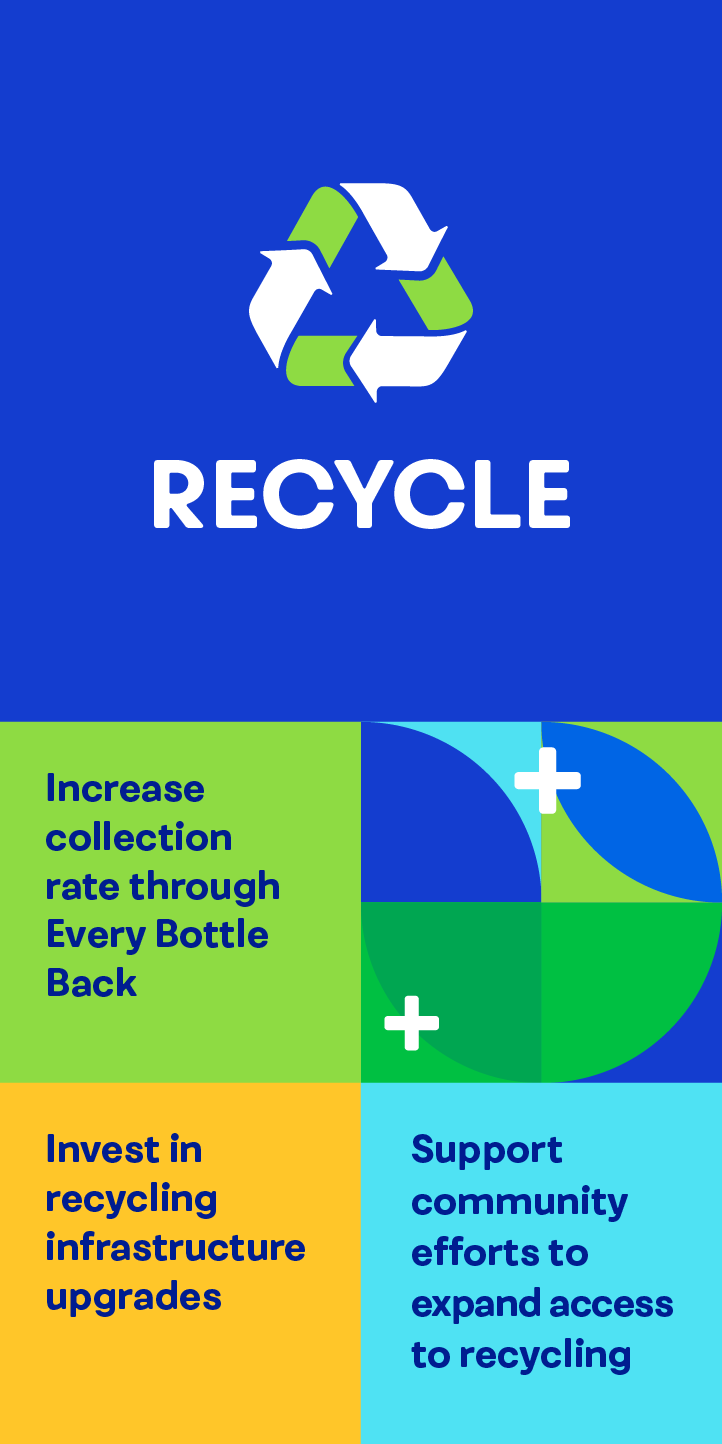
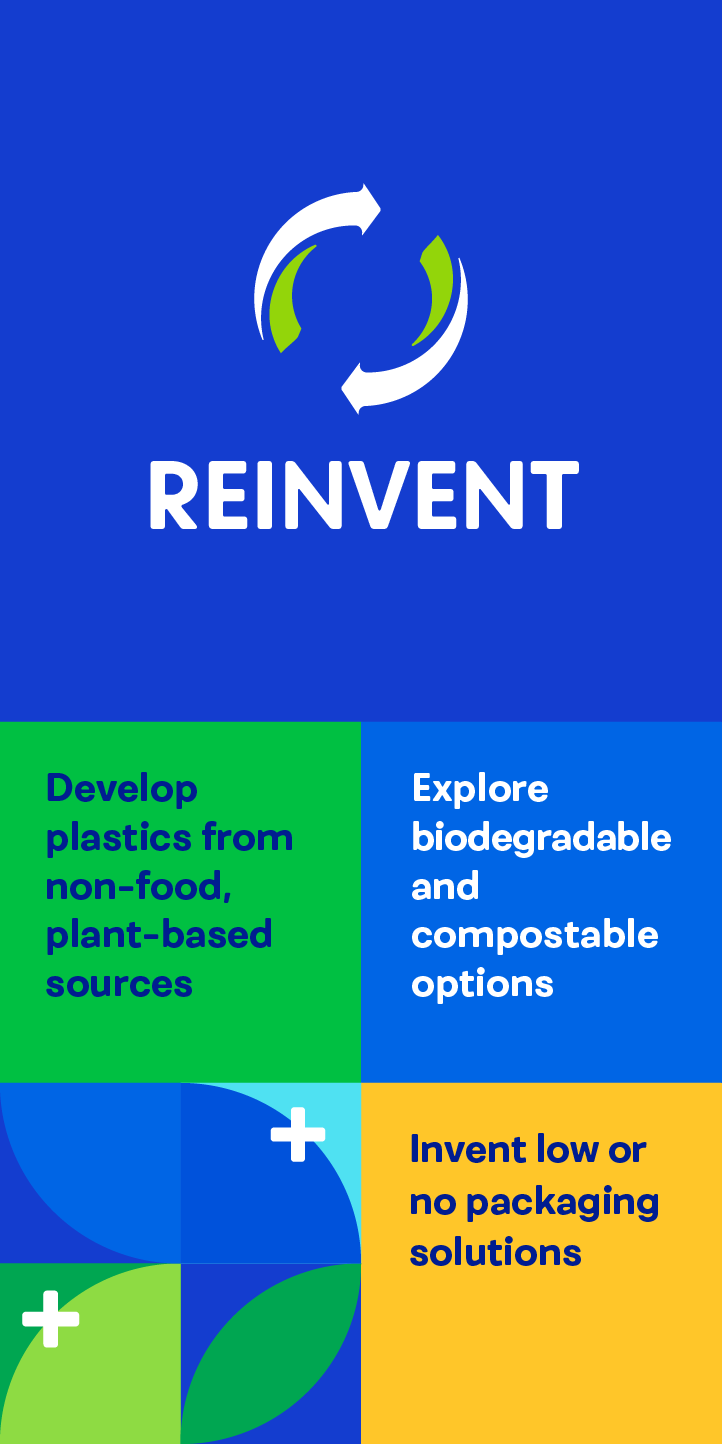
Goals & progress
Virgin plastic reduction goal
![Cut virgin plastic from non-renewable sources per serving across our global beverages and convenient foods portfolio by 50% [footnote 1] [footnote 2]](https://usa-pepsicoredesign-global-prod.pepext.com/images/default-source/sustainability/2021-esg-summary/pepsico-esg21_chart_value-chain-packaging-goals-and-progress-1.png)
Minimize single-use packaging materials goal

Non-renewable virgin plastic reduction goal
![Reducing our absolute tonnage of virgin plastic derived from non-renewable sources by 20% [footnote 1] [footnote 3]](https://usa-pepsicoredesign-global-prod.pepext.com/images/default-source/sustainability/2021-esg-summary/pepsico-esg21_chart_value-chain-packaging-goals-and-progress-3.png)
Bio-based and recycled plastic reduction goal
![Use of market-leading bio-based materials and increase incorporation of recycled content (50% across plastics) [footnote 4]](https://usa-pepsicoredesign-global-prod.pepext.com/images/default-source/sustainability/2021-esg-summary/pepsico-esg21_chart_value-chain-packaging-goals-and-progress-4.png)
2. Goal expanded in 2021 to 50% for beverages and convenient foods.
3. 2021 performance impacted by increased plastic use due to business growth.
4. Goal timeline extended to 2030 and goal expanded to 50% recycled content.
Approach
At PepsiCo, we recognize the role we can play in creating a circular economy for packaging. We’re aspiring to use our reach and influence to help change the way society makes, uses and disposes of packaging. Yet systemic change is not something we—or any single organization—can accomplish alone. We’re in dialogue with policy makers and working with industry coalitions, producer responsibility organizations, trade associations and community-based organizations throughout the packaging value chain to improve infrastructure, advocate for sustainable policies and accelerate innovation.
We’ve announced ambitious new goals around our aim to reduce our use of virgin plastic, use more recycled content in our plastic packaging and scale business models like SodaStream that avoid or minimize single-use plastic. These new targets complement our 2025 goal of making 100% of our packaging recyclable, compostable, biodegradable or reusable.
Achieving these ambitious goals requires investment and innovation. We face challenges from the limitations of existing technology and regulations. But our commitment to continue to strive toward these goals is unwavering. That’s why we’re scaling new business models that avoid or minimize single-use packaging materials. These include models that reuse, refill, prepare at home or utilize concentrates like powders or drops. We’re also seeking to use market-leading bio-based materials and more recycled content (50% across our plastic packaging) to reduce absolute tonnage of virgin plastic from non-renewable sources across our entire portfolio. To further reduce use of single-use plastic packaging, we plan to set a time-bound goal by the end of 2022 for a percent of volume of beverages to be delivered via strategies that avoid or minimize single-use packaging, such as reusable and refillable bottles or containers.
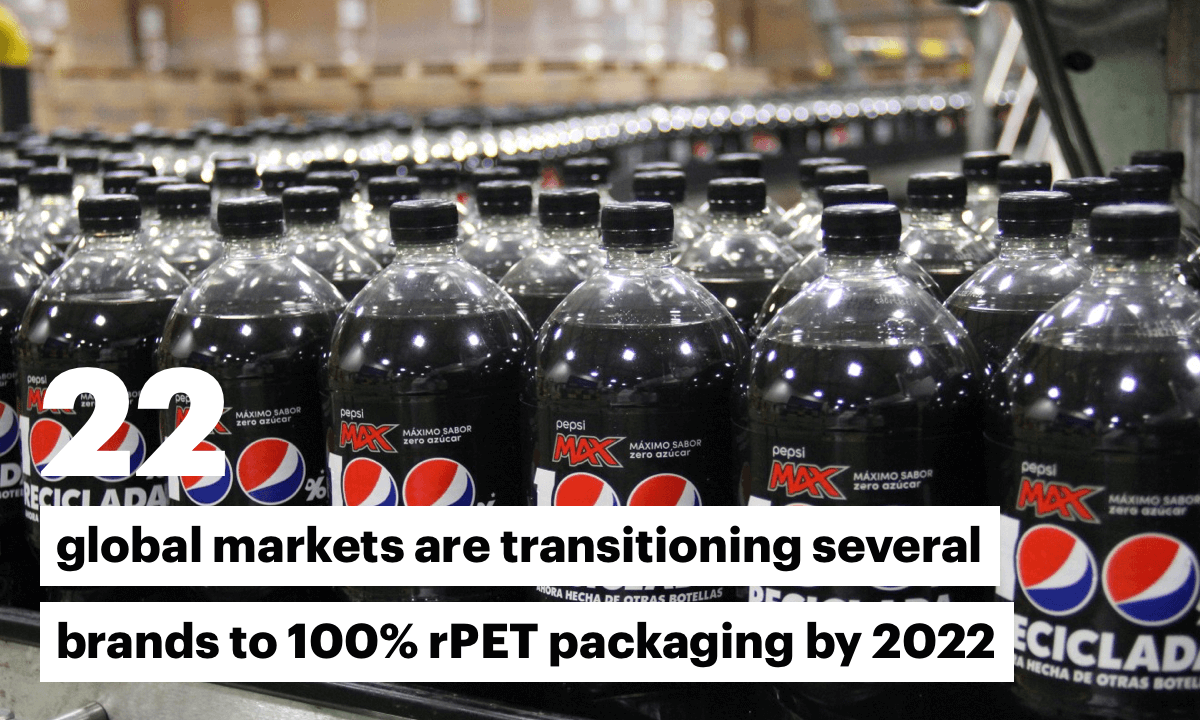
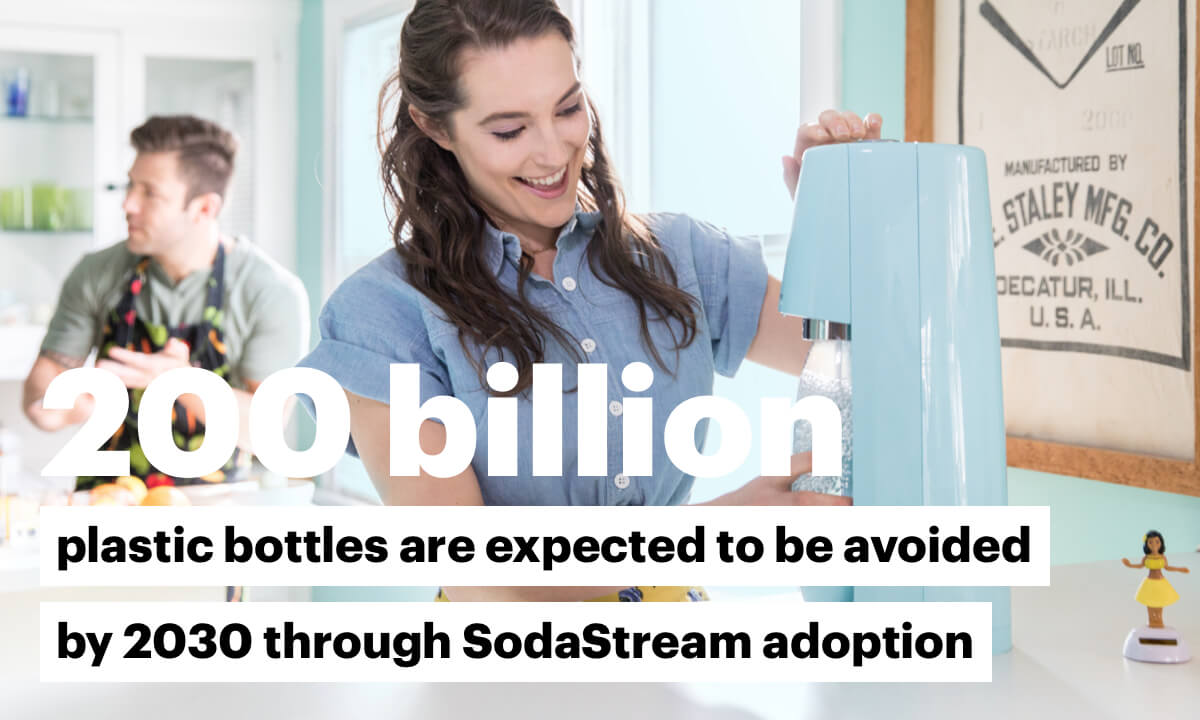
In 10 European markets, key Pepsi-branded1 products are expected to switch to 100% rPET2 bottles by 2022. Moving to rPET bottles is estimated to reduce GHG emissions by roughly 30% per bottle. In the U.S., we sell LIFEWTR in 100% rPET bottles and Pepsi Zero Sugar will begin to be sold in 100% rPET bottles by the end of 2022 (we plan to convert all Pepsi-branded products in the U.S. to 100% rPET bottles by 2030).
In 2021 and 2022, we launched 100% rPET beverage products in Australia, New Zealand, Vietnam and Argentina. We are transitioning several brands to 100% rPET across 22 global markets.
In early 2022, PepsiCo Europe set a new ambition to use 100% recycled or renewable plastic in all crisp and chip packets by 2030, which is expected to reduce GHG emissions from film packaging for food by up to 40%.
2. Abbreviation for “recycled PET (polyethylene terephthalate)” plastic.
Sustainable packaging goal
![Design 100% of packaging to be recyclable, compostable, biodegradable or reusable by 2025. 2021: 87% [footnote 1]](https://usa-pepsicoredesign-global-prod.pepext.com/images/default-source/sustainability/2021-esg-summary/pepsico-esg21_chart_value-chain-packaging-goals-and-progress-5.png)
Approach
We are exploring renewable, non-fossil-fuel-based sources for packaging materials, such as plant-based materials that are safe, efficient and have a lighter carbon footprint than fossil-fuel based plastics. We prioritize materials that avoid the use of food resources or virgin plastics, like bio-based materials, and have partnered with other organizations to develop these materials and scale new technologies.
We are a member of the NaturALL Bottle Alliance and its effort to significantly reduce the carbon footprint of beverage containers, and work with the Pulpex consortium to develop the world’s first fully recyclable paper bottle that we are working to commercialize and scale.
To reduce plastics across primary, secondary and tertiary packaging, we have light-weighted our bottles, reduced thickness of our films and cut down on shipping and other packaging materials.
By investing in breakthrough food packaging technology, we are now able to introduce a commercially compostable bag made of plant-based materials. Our Frito-Lay plant-based brand Off The Eaten Path offers this commercially compostable packaging in the U.S. at Whole Foods stores. To support our goal of creating a circular food packaging system, we license this technology to other companies at no cost.
We're also continuing to scale new business models that avoid or minimize single-use packaging materials.
Recycling rate goal
![Invest to increase recycling rates in key markets by 2025 [footnote #1]](https://usa-pepsicoredesign-global-prod.pepext.com/images/default-source/sustainability/2021-esg-summary/pepsico-esg21_chart_value-chain-packaging-goals-and-progress-6.png)
Approach
Systemic change requires partnership across the packaging supply chain. PepsiCo is working with peers, policy makers and innovators to drive progress toward a circular economy. We’re helping to develop infrastructure, advocating for smart policies and engaging consumers so that packaging never becomes waste. We support well-designed Extended Producer Responsibility (EPR) policies and are investing resources and expertise into recycling infrastructure improvements.
Since 2018, PepsiCo and the PepsiCo Foundation have announced more than $100 million to global recycling partnership initiatives to help elevate recycling rates and waste collection. In late 2021 and early 2022, we announced we will invest $15 million in the Closed Loop Partners’ (CLP) Leadership Fund, a private equity fund focused on strengthening recycling infrastructure and building circular supply chains, and $35 million to help create the Closed Loop Local Recycling Fund, to advance new small-scale, modular recycling systems in communities across the U.S. We are also a founding partner of CLP’s Composting Consortium, a founding member of the Closed Loop Infrastructure Fund, and have invested in the CLP Beverage Fund through American Beverage's Every Bottle Back Initiative.
Explore Packaging topics in more depth
PepsiCo's ESG Topics A-Z resource provides detail on strategy, data, policy, progress and more on a wide range of subjects.
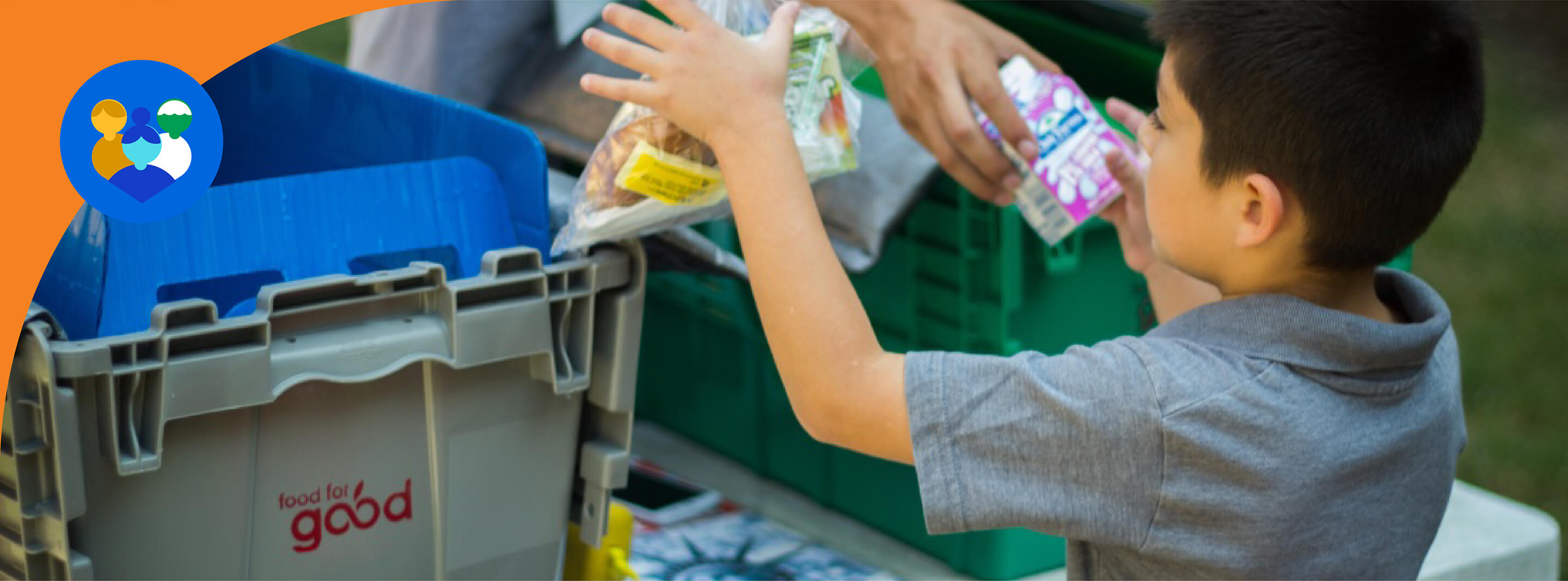
People
People
Helping to create a more diverse, equitable and inclusive workplace and world is the right thing to do. It's also a business imperative.
As a leading global company, we have a unique opportunity to use our scale and influence to help address societal challenges. We will continue to help address inequalities for historically marginalized people and underserved businesses and communities.
Our positive impact on people
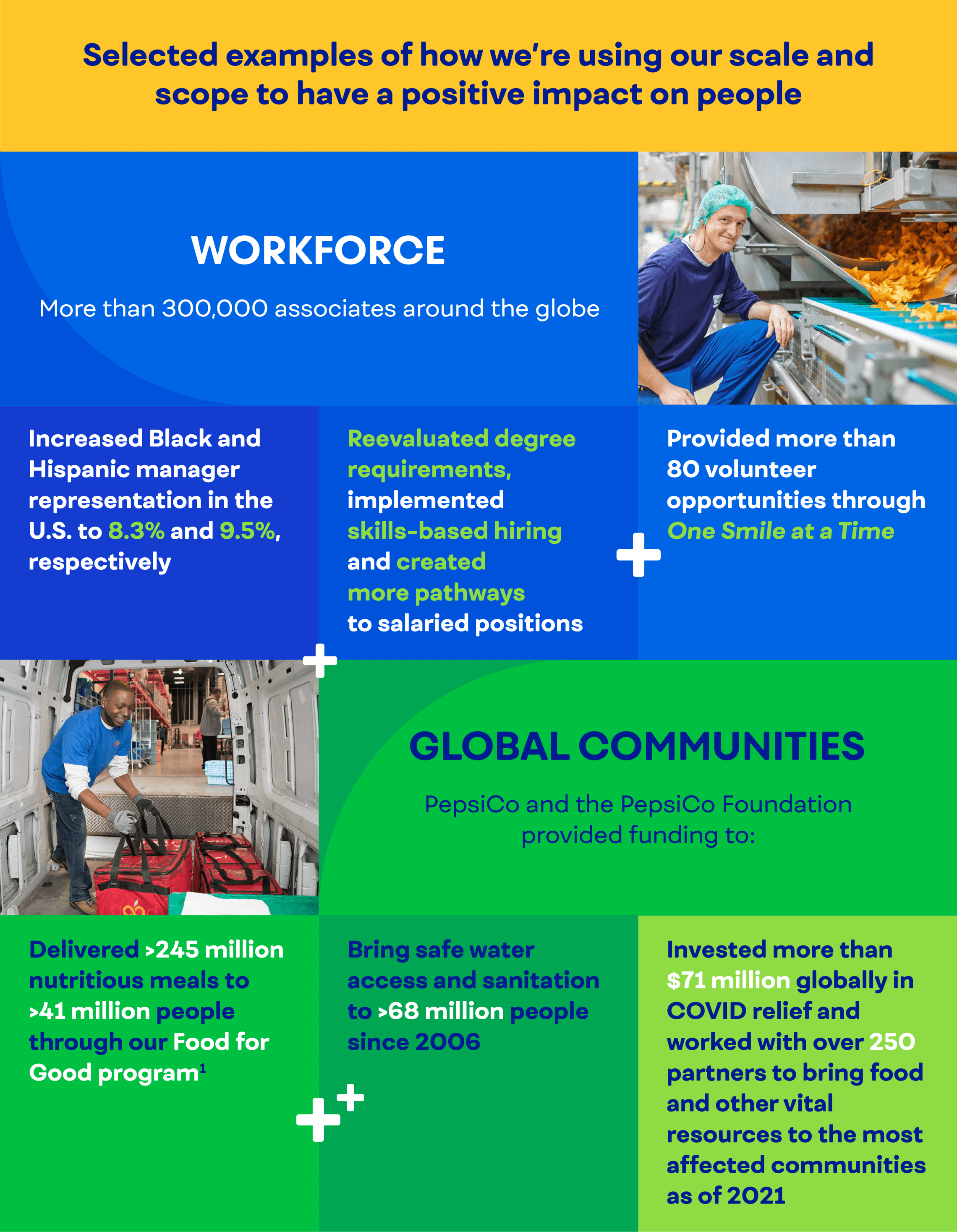
Goals & progress
Provide meaningful jobs and growth opportunities for our people and empower them to make a positive impact at work, at home and in their local communities
Job growth goal
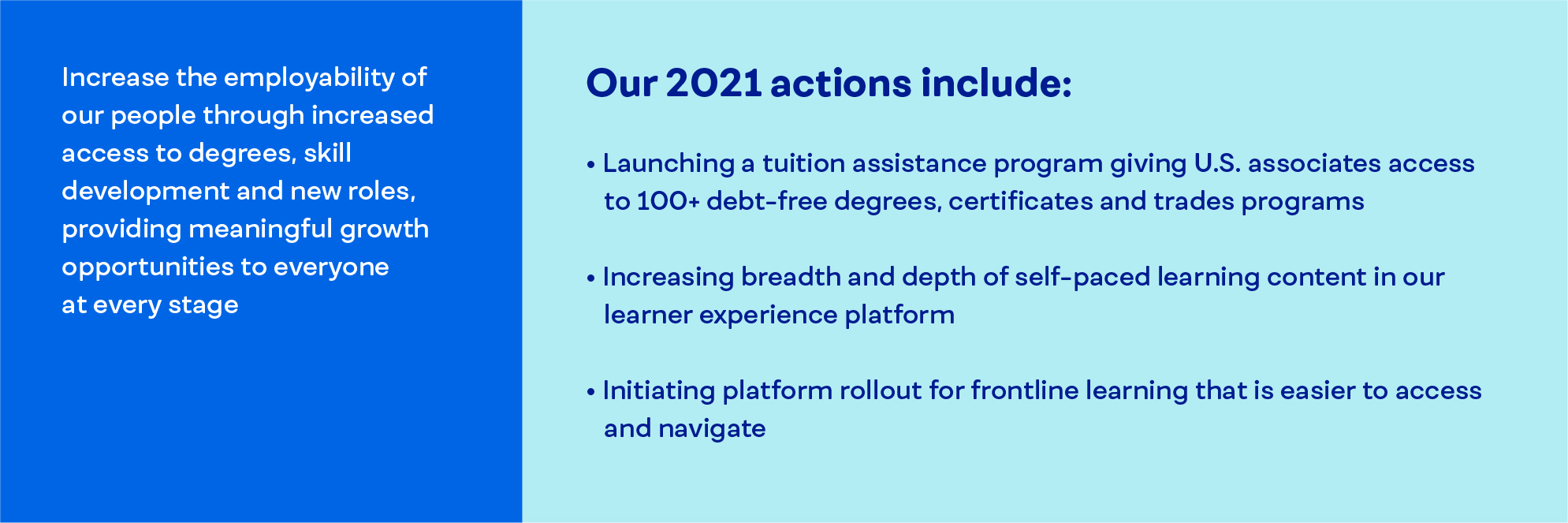
Volunteer growth goal
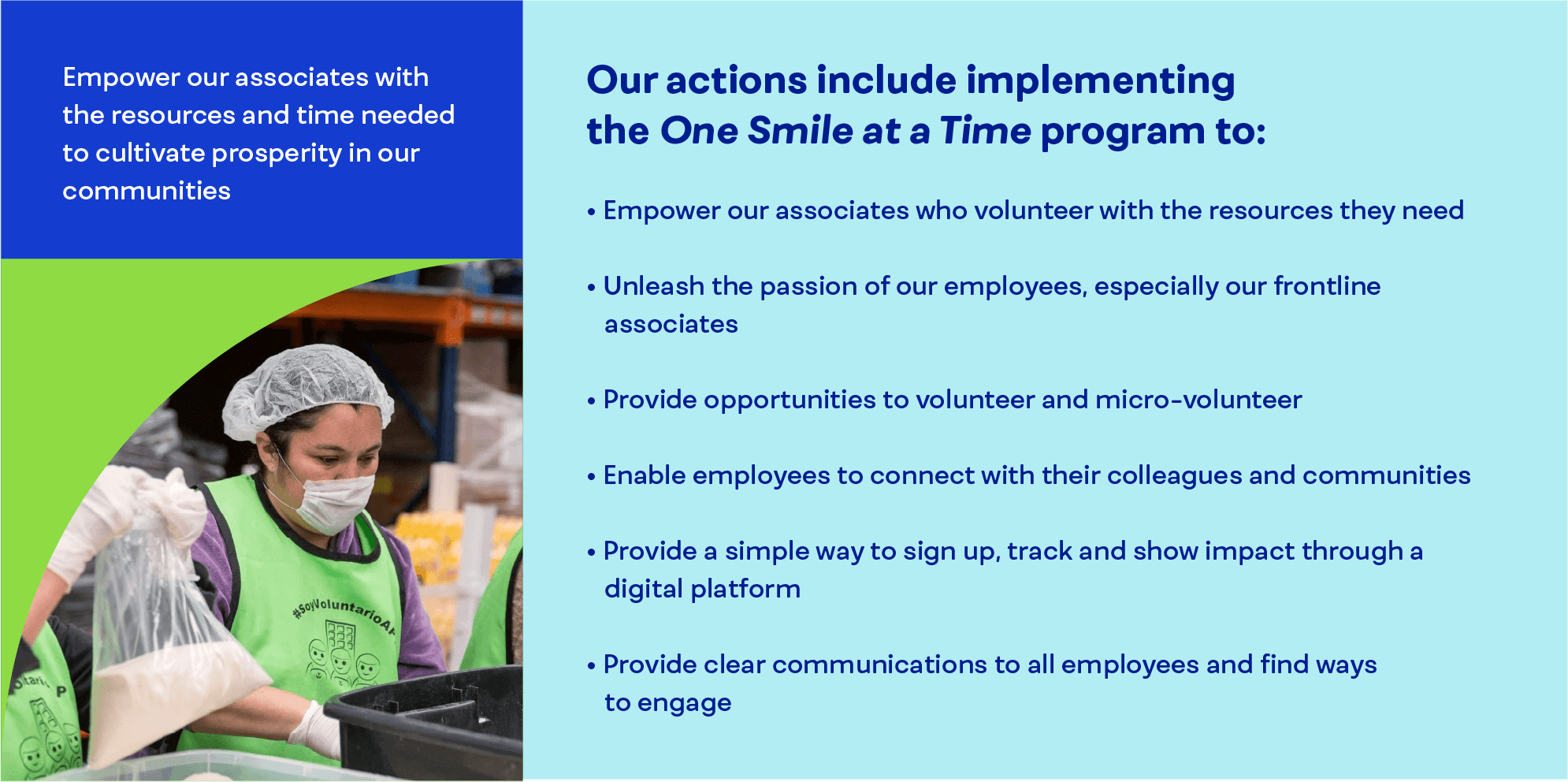
Approach
PepsiCo has a history of investing in programs and initiatives to help our associates grow and develop. Today we are building on that history with new programs aimed at making PepsiCo an even better place to work and empowering our associates to make a greater impact on their communities.
At the same time, we are ensuring that our associates have the skills that our business needs to succeed in the future.
We have launched digital learning and development platforms on a global basis as part of our plan to digitize the employee experience and make it easier for associates to connect and collaborate regardless of location. This digitization is made possible by providing employees with new technology solutions such as occupancy sensors, a workspace reservation app, smartboards and integrated meeting technology.
We are developing new training, upskilling and advancement programs aimed at providing meaningful growth opportunities to associates at every career stage. For example, myeducation is a new debt-free program that will help more than 100,000 frontline and professional U.S.-based associates develop their capabilities and take their career in a new direction. myeducation offers access to more than 100 flexible education and upskilling programs from highly reputable schools and universities. PepsiCo will cover 100% of tuition costs, books and fees for a wide variety of education programs within the debt-free catalog.
Frontline associates are the core of our workforce, and we want to make sure they can build meaningful careers. We’re creating greater transparency around frontline job opportunities, reevaluating degree requirements for roles and eliminating these where possible, implementing skills-based hiring and developing pathways to salaried positions.
Yet a meaningful job is more than day-to-day responsibilities. Our One Smile at a Time program is a local volunteer initiative to encourage, support and empower associates with the resources and time needed to cultivate prosperity in their community. One Smile at a Time is accessible in more than 21 languages and provides a framework, resources and infrastructure for associates to access and register for volunteering opportunities through the PepsiCo Foundation, our Employee Resource Groups, Green Teams and our individual brands.
Goals, progress & approach
Build a better workplace and world by advancing human rights and diversity, equity and inclusion (DE&I) for our people, in our business partnerships and our communities
Racial Equality Journey managerial representation goals
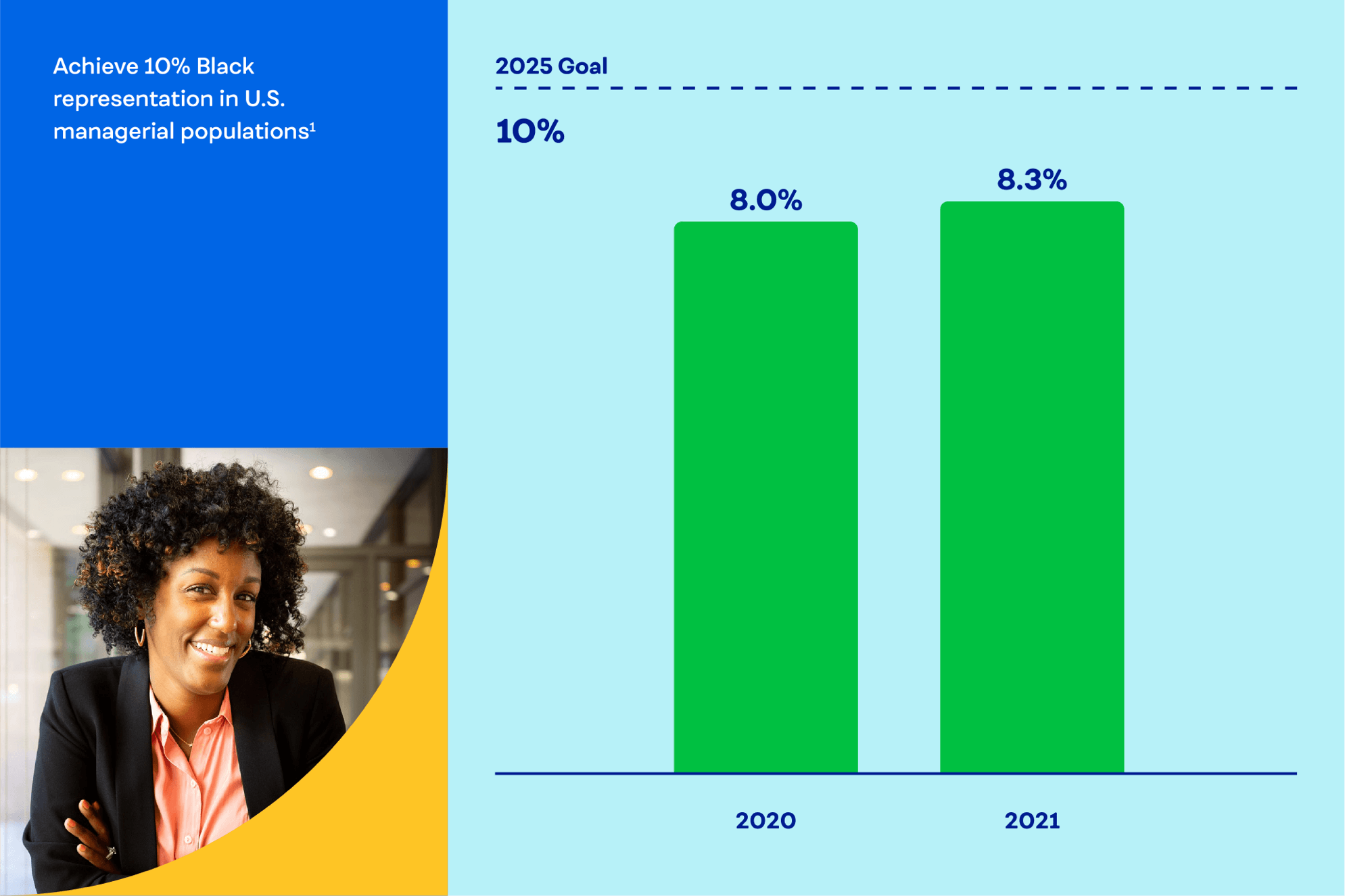
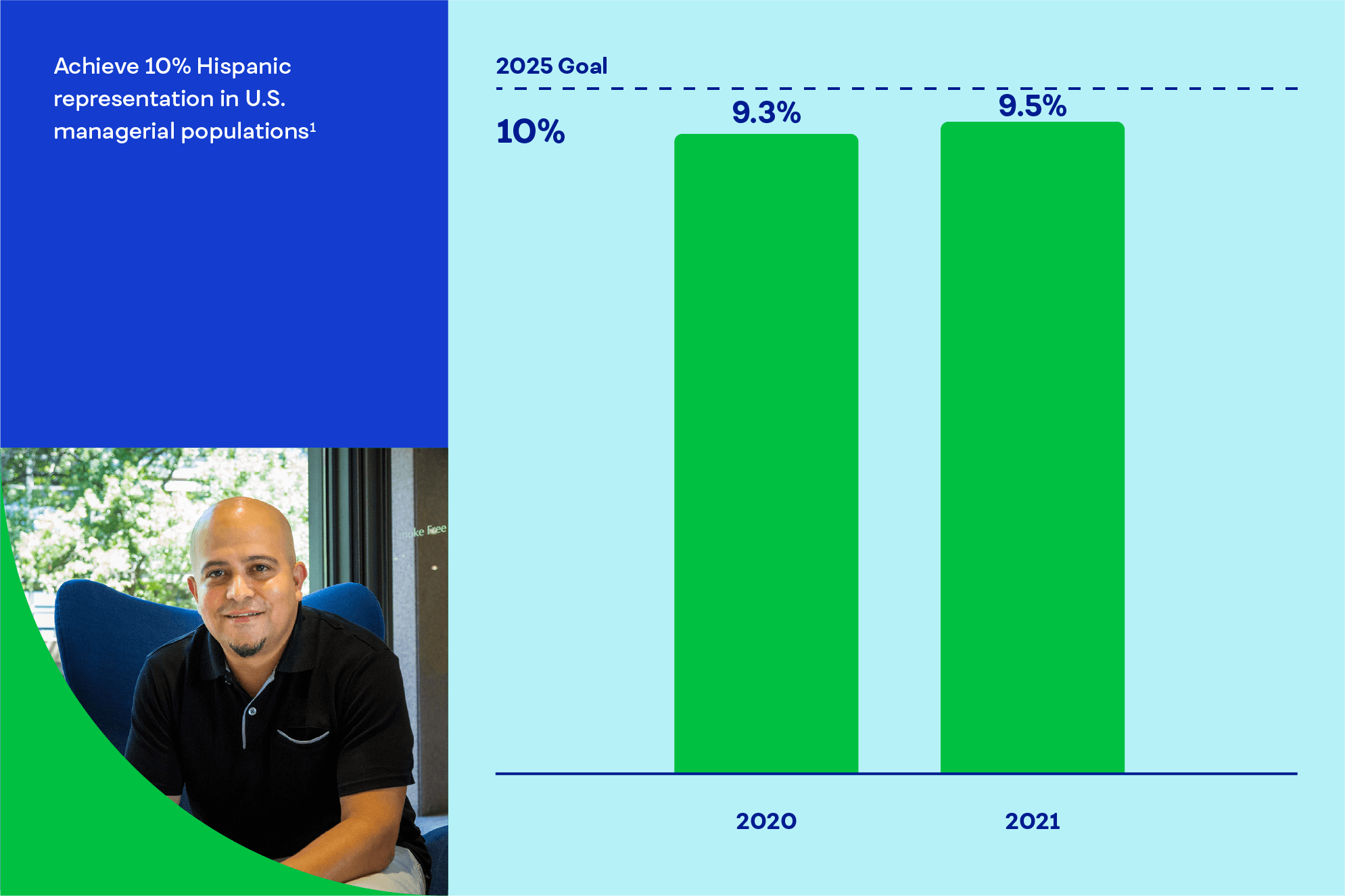
In 2020, we launched our Racial Equality Journey (REJ), a more than $570 million set of commitments with a focus on three pillars: People, Business and Communities. Within our own walls, we focused on increasing the representation of Black and Hispanic associates at PepsiCo, to mirror the workforce availability of the communities where we work, through active recruitment, education, internships and apprenticeships. Outside our walls, we’re using our scale and influence across suppliers and strategic partners to increase Black and Hispanic representation and elevate diverse voices. In our communities, we’re working to drive long-term change by addressing systemic barriers to economic opportunity and advancing economic empowerment for Black and Hispanic Americans.
Reduced inequalities goal
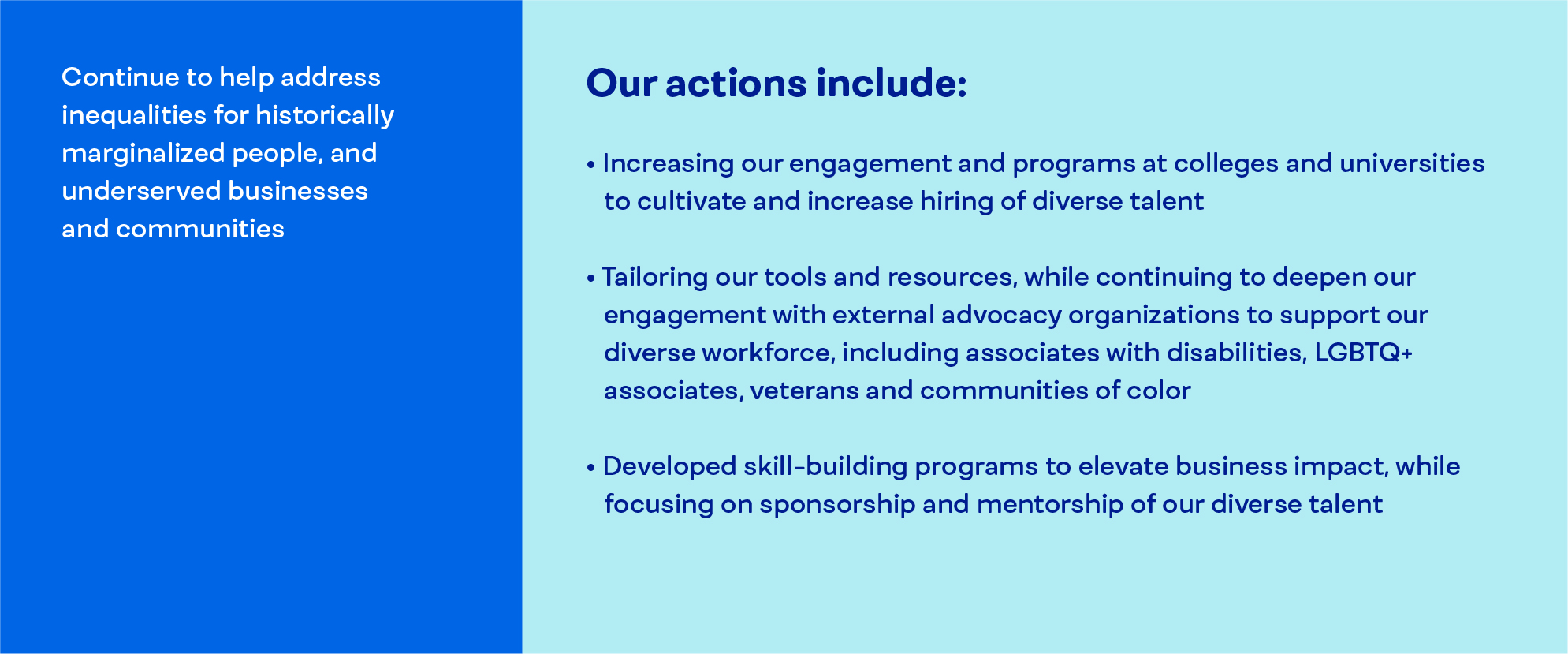
We’ve expanded our supplier base and are on track to increase our spending with Black and Hispanic suppliers by more than $500 million by 2025. We launched the $50 million Juntos Crecemos platform to strengthen Hispanic-owned businesses (specifically restaurants, bodegas and meat markets), address foundational business challenges and support business growth over five years.
The PepsiCo Foundation created the IMPACTO Hispanic Business Accelerator to provide $10 million in funding to help 500 Hispanic small food and beverage business owners in 13 cities across the U.S., and launched a $10 million investment with the National Urban League (NUL) to launch the Black Restaurant Accelerator Program. Over the course of the five-year program, the PepsiCo Foundation and NUL will provide 500 Black restaurant owners in 12 cities with capital, technical assistance and mentorship services.
PepsiCo and the PepsiCo Foundation created a new $40 million scholarship and professional mentoring program to support Black and Hispanic aspiring and graduating community college students. The program aims to support 4,000 students over five years.
Women in management goal
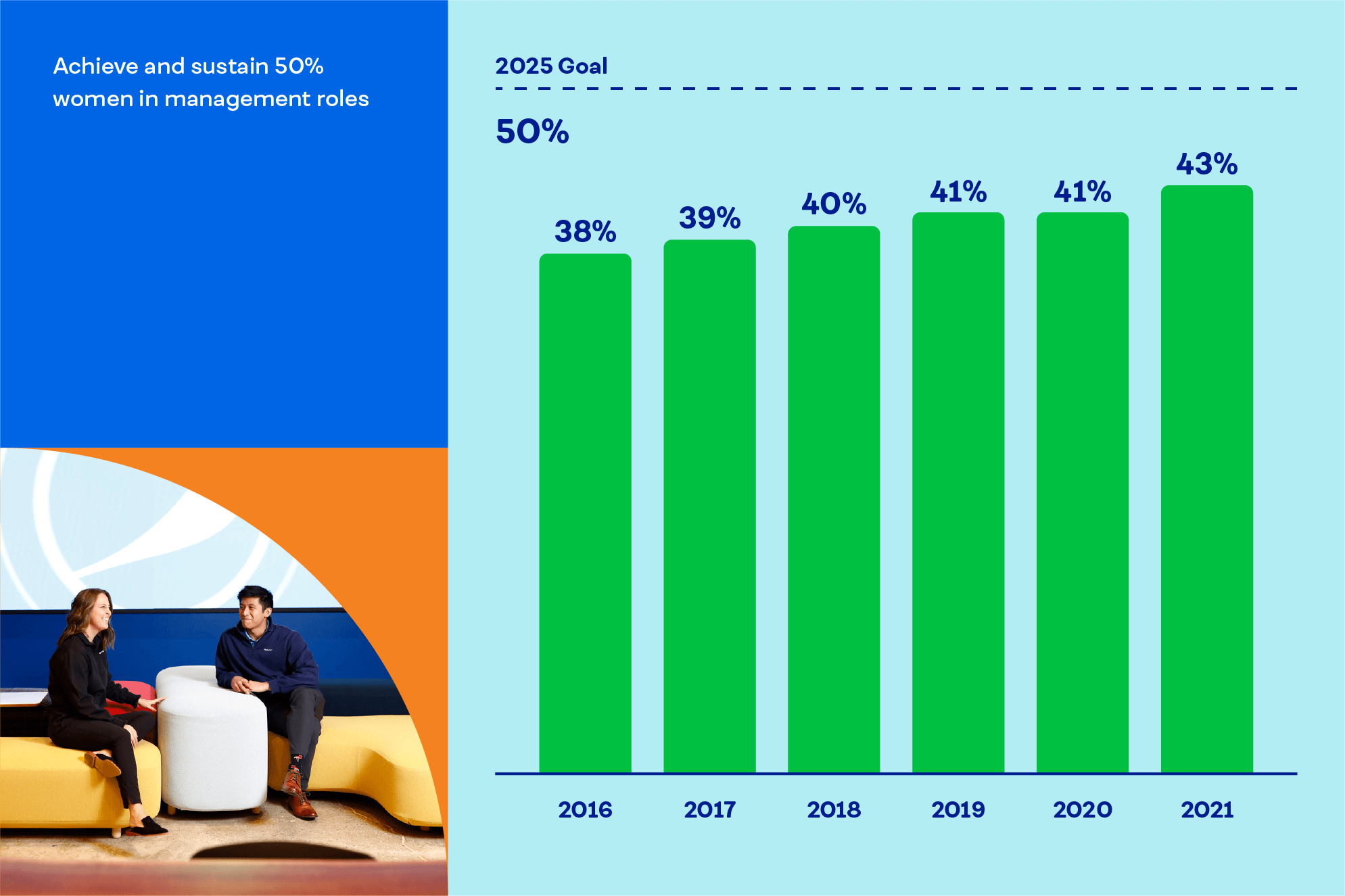
We believe that ensuring that women have equal access to employment and promotion is necessary for a prosperous and sustainable society.
As part of our commitment to making actionable improvements for women, we are focused on retaining and growing diverse talent through mentoring, coaching and development programs throughout career stages. These efforts include our Women with Purpose program, a partnership with FUNDES Latin America that provides education, employment and entrepreneurship opportunities to more than 12,000 women from 2016–2022. We are investing approximately $1.8 million in this program.
Pay equity goal
![Achieve and sustain pay equity for our global professional population by maintaining a comprehensive global pay equity review process. Women and men are paid within 1% of each other. [footnote 1]](https://usa-pepsicoredesign-global-prod.pepext.com/images/default-source/sustainability/2021-esg-summary/pepsico-esg21-chart_value-chain-people-goals-and-progress-7.png)
We have a longstanding review process designed to promote pay equity across employee groups. We’re building on that history as we strive to achieve our goal of pay equity by implementing a more comprehensive global pay equity review process. In 2021, we implemented this process in 72 countries that collectively make up more than 99% of our salaried employee population. Our results show that among this population, women and men are paid within 1% of each other (based on base compensation), after controlling for legitimate drivers of pay such as job level, geographic location and performance ratings.
Supplier Code of Conduct goal

Human rights goal
![Promote fair and safe working conditions for all by advancing respect for human rights everywhere we operate and throughout our business activities [footnote 1]](https://usa-pepsicoredesign-global-prod.pepext.com/images/default-source/sustainability/2021-esg-summary/pepsico-esg21-chart_value-chain-people-goals-and-progress-9.png)
We recognize that success can only be achieved when all our stakeholders—including farmers and growers, factory workers and community partners—are treated with dignity and respect. PepsiCo is committed to respecting the rights of all workers and communities throughout our value chain. To help ensure we are in the best position to prevent, identify and address potential impacts, we established a global human rights approach that is guided by the United Nations Guiding Principles on Business and Human Rights (UNGPs).
As part of this approach, we focus our efforts on our most salient human rights issues — those at risk of the most severe negative impacts through our company activities and business relationships. We identified vulnerable worker groups — including migrant workers, women, young workers and temporary/contract workers — as a salient issue for our value chain and are taking action to address the human rights impacts faced by these groups. For instance, we recently joined the Leadership Group for Responsible Recruitment, a collaboration between leading companies and expert organizations to drive positive change in the way migrant workers are recruited. Through our engagement, we are collaborating with other global brands to embed the Employer Pays Principle and advocate for improved protections for migrant workers throughout the value chain.
Injury-free work environment goal
![Continue to strive for an injury-free work environment [footnote 1] [footnote 2]](https://usa-pepsicoredesign-global-prod.pepext.com/images/default-source/sustainability/2021-esg-summary/pepsico-esg21-chart_value-chain-people-goals-and-progress-10.png)
2. 2021 and 2020 results reflect the exclusion of SodaStream and Pioneer Foods. 2019 results reflect the exclusion of SodaStream.
We are committed to respecting human rights and driving fair and safe working conditions throughout our value chain, including maintaining high safety standards and targeting an injury-free work environment.
Safe water access goal
![Reach 100 million people with safe water access [footnote 1]](https://usa-pepsicoredesign-global-prod.pepext.com/images/default-source/sustainability/2021-esg-summary/pepsico-esg21-chart_value-chain-people-goals-and-progress-11.png)
Access to clean, safe water is a fundamental human right and essential for health, well-being, dignity and economic mobility. In this era of COVID-19, safe water access is more important than ever. We’ve established strong partnerships with leading NGOs to drive watershed replenishment efforts, and last year alone we replenished more than 6.1 billion liters of water into local watersheds. PepsiCo and the PepsiCo Foundation are already more than halfway to our goal of delivering safe water access to 100 million people by 2030.
Food security goal
![Partner with communities to advance food security and make nutritious food accessible to 50 million people [footnote 1]](https://usa-pepsicoredesign-global-prod.pepext.com/images/default-source/sustainability/2021-esg-summary/pepsico-esg21-chart_value-chain-people-goals-and-progress-12.png)
Throughout the world, communities with better nutrition are more likely to flourish. Children are better educated, economies grow and people live healthier, better lives. PepsiCo and the PepsiCo Foundation are working to make nutritious food more accessible for underserved communities around the globe with a goal of providing nutritious food to 50 million people by 2030 (against a 2021 baseline), and providing safe water access to 100 million people (against a 2006 baseline).
For over a decade we’ve been partnering with leading organizations to increase access to nutritious food for children and their families around the world through Food for Good, our global commitment to advance food security in communities where we live and work. These collaborative efforts and investments range from short-term food access to long-term solutions to hunger.
We partnered with the U.S. Department of Agriculture, the Baylor University Collaborative on Hunger and Poverty (BCHP) and Food for Good to ship millions of meals directly to the doorsteps of displaced children in rural communities. Meal boxes delivered by postal workers provided two weeks’ worth of shelf-stable, individually packaged nutritious food that met USDA’s summer food requirements.
Explore People topics in more depth
PepsiCo's ESG Topics A-Z resource provides detail on strategy, data, policy, progress and more on a wide range of subjects.
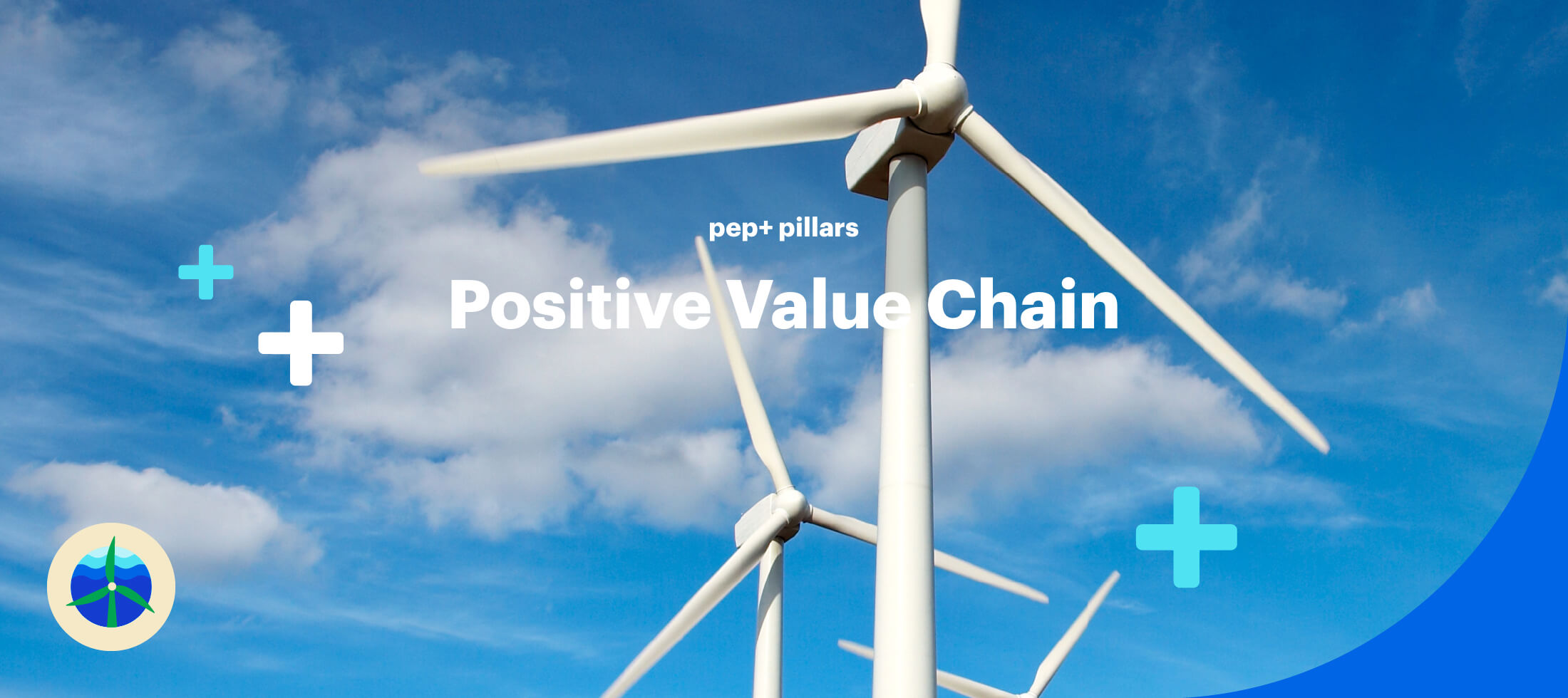

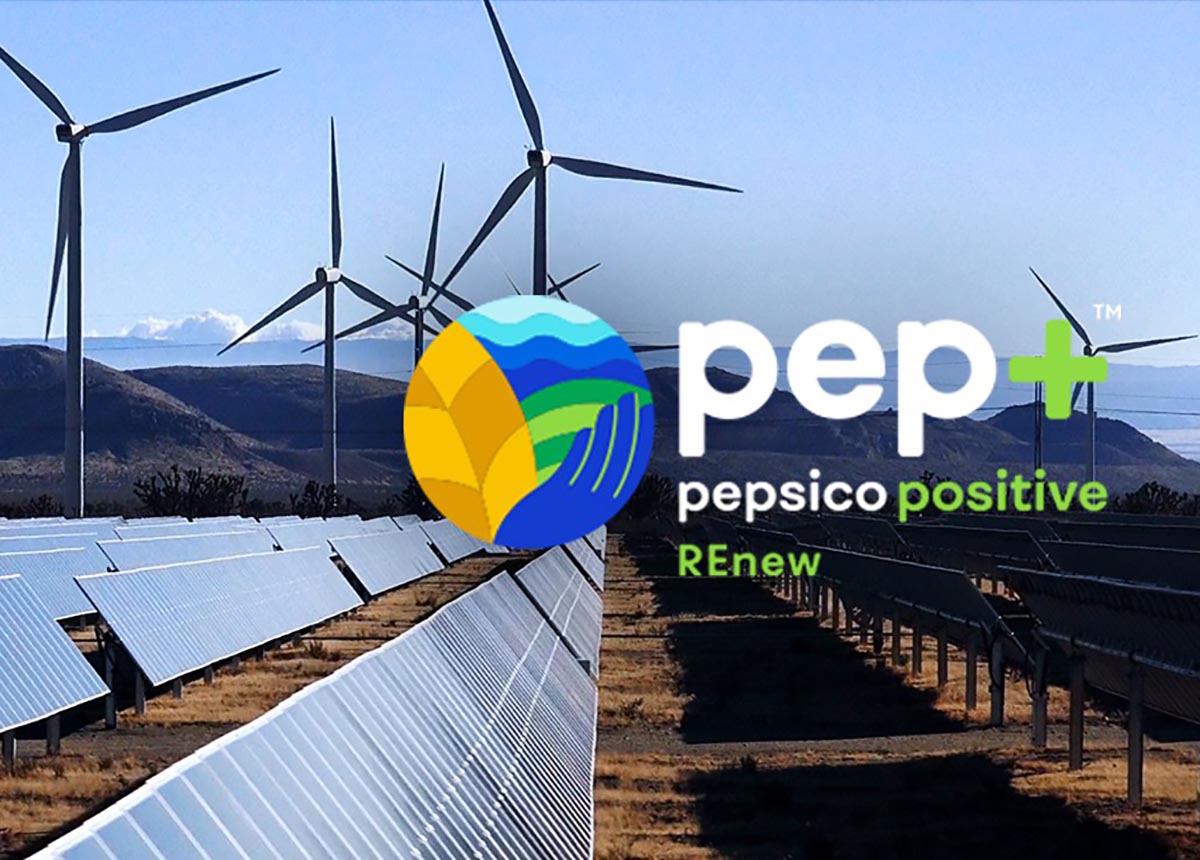
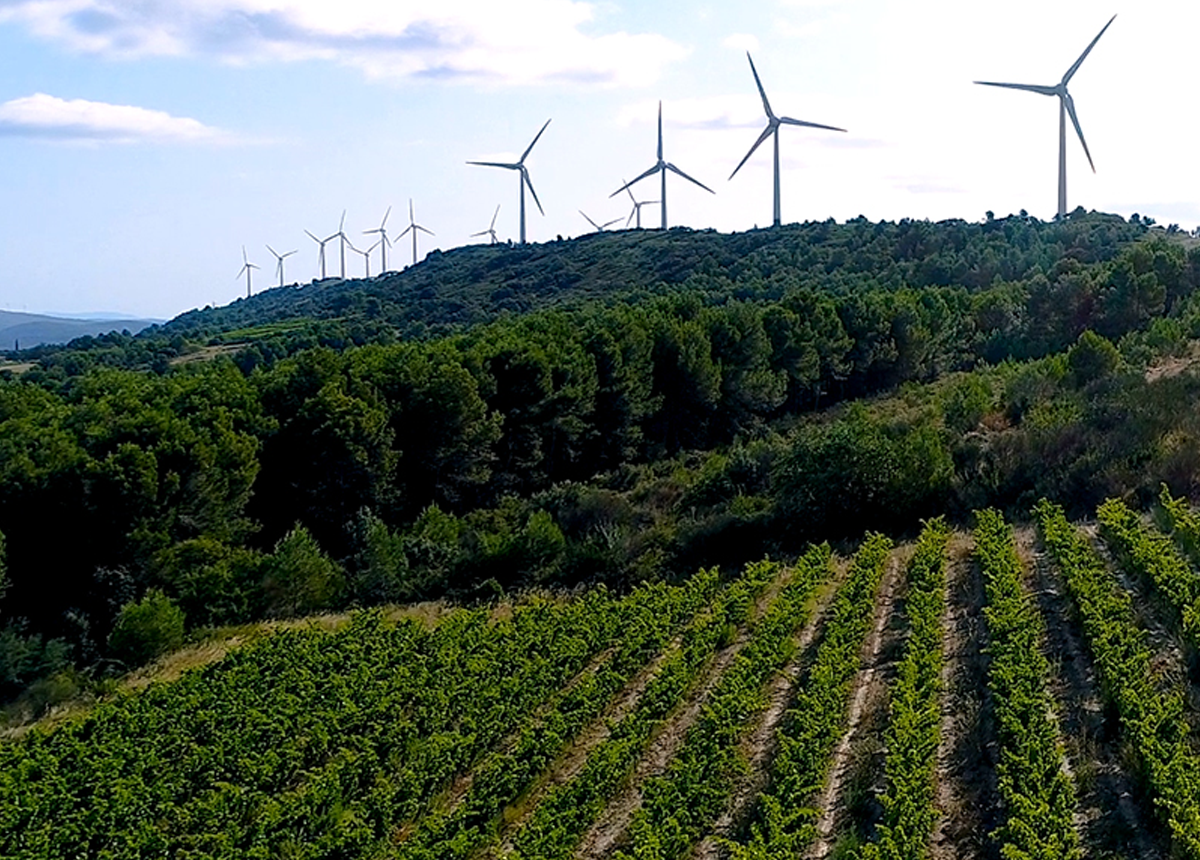
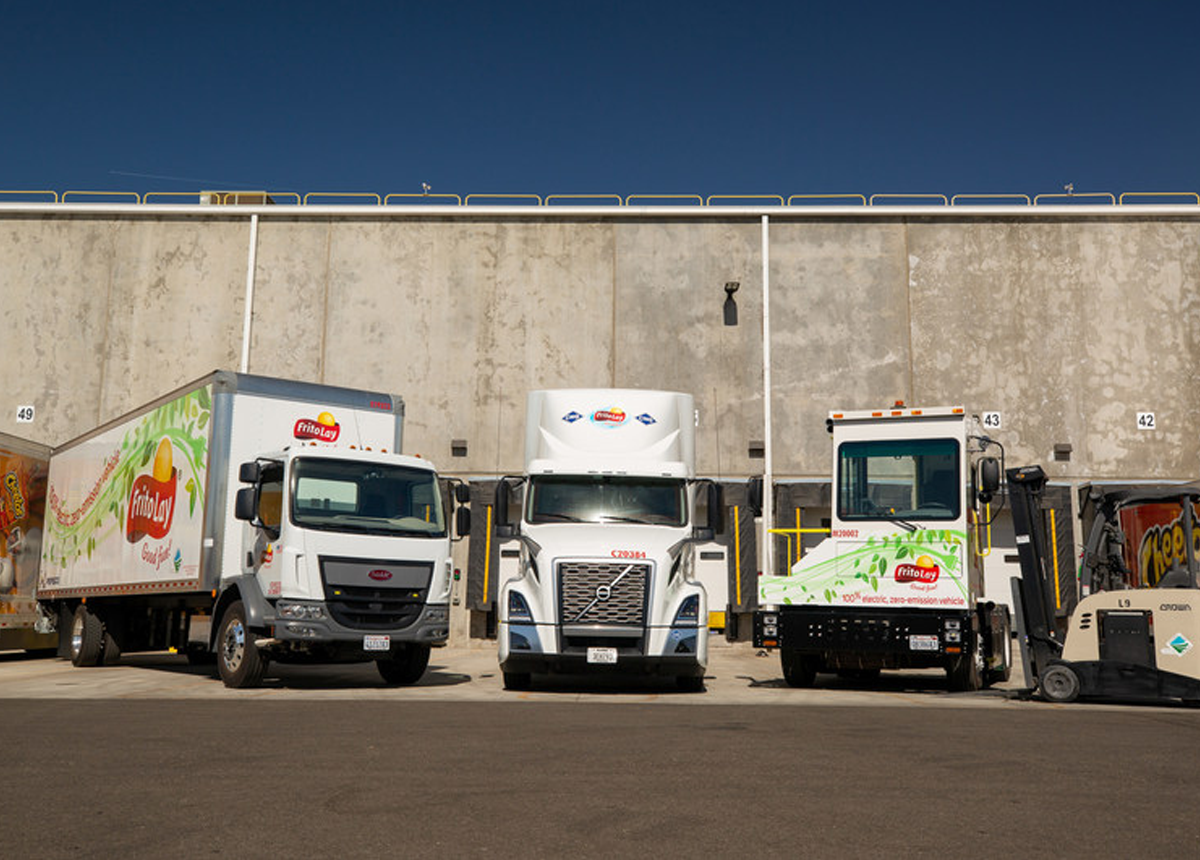
.png)
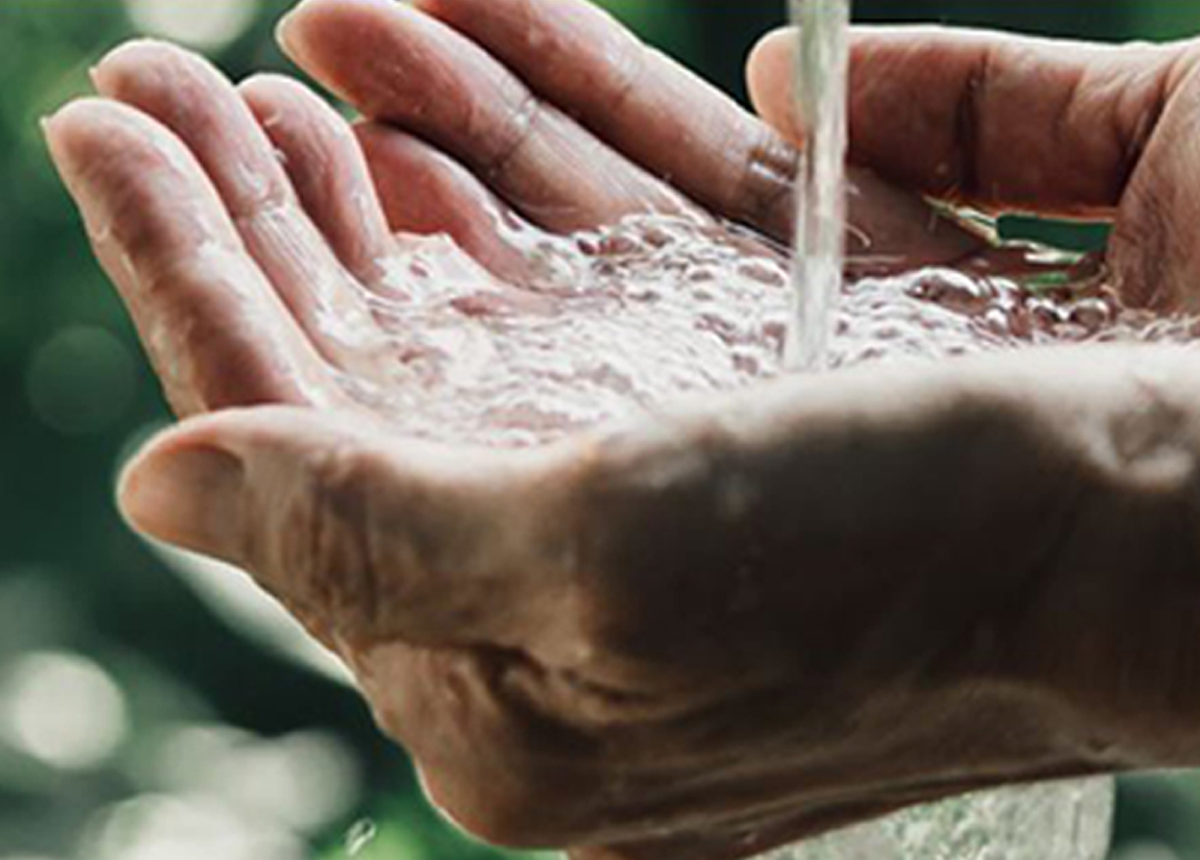
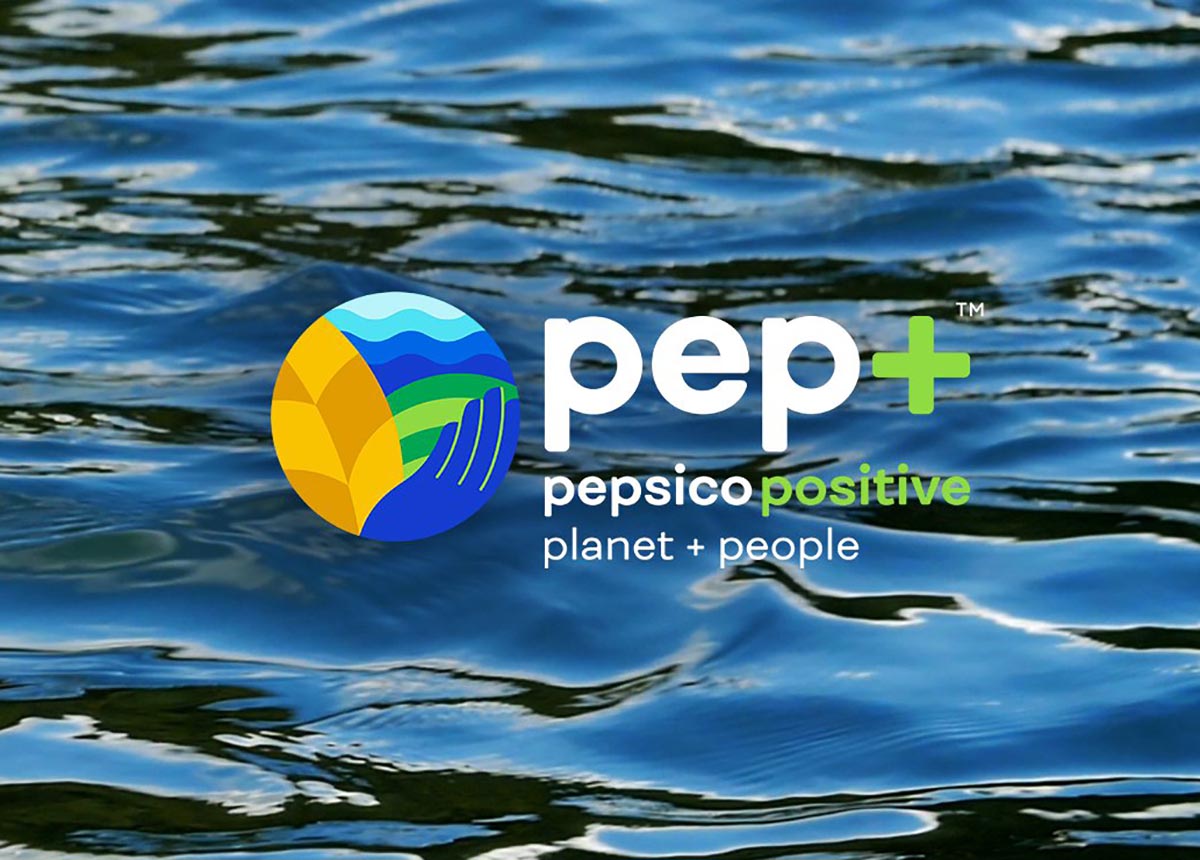
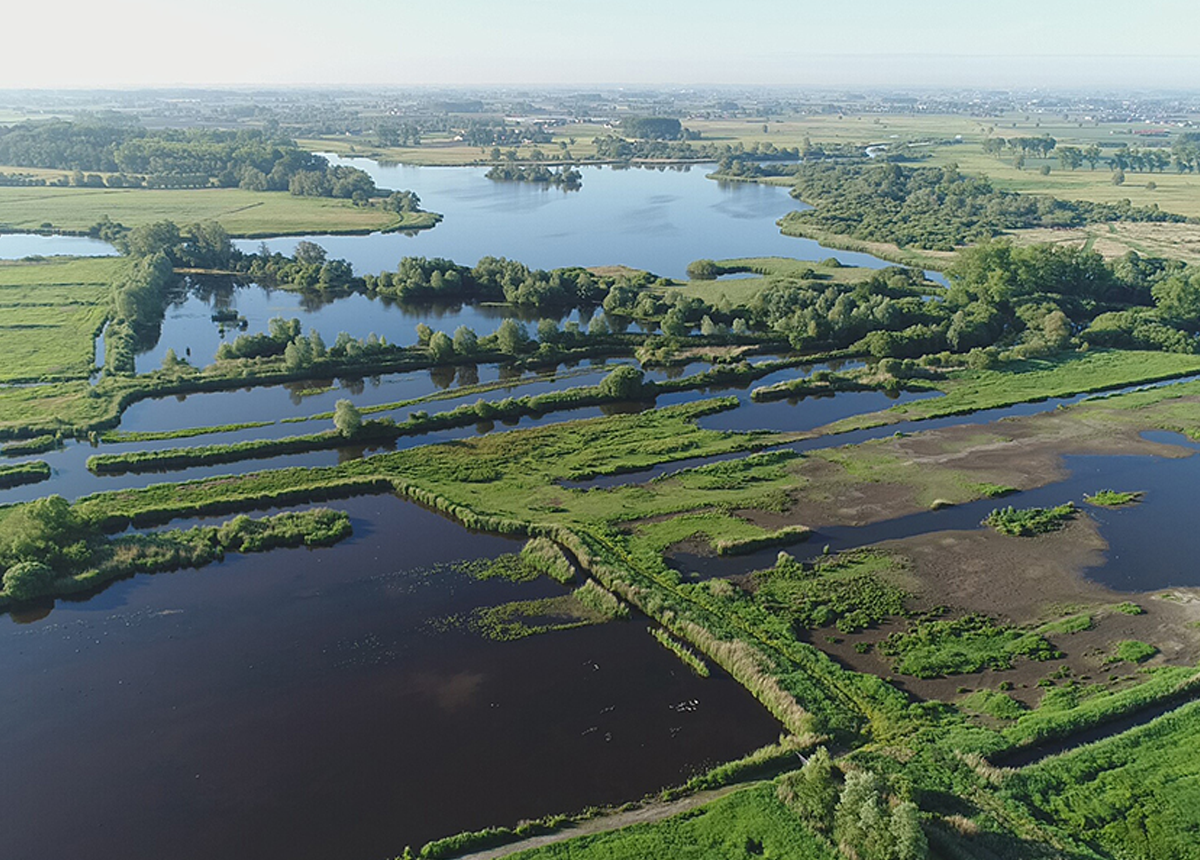
e624b97c397b4a35950ab3a8d5917cc3.png)
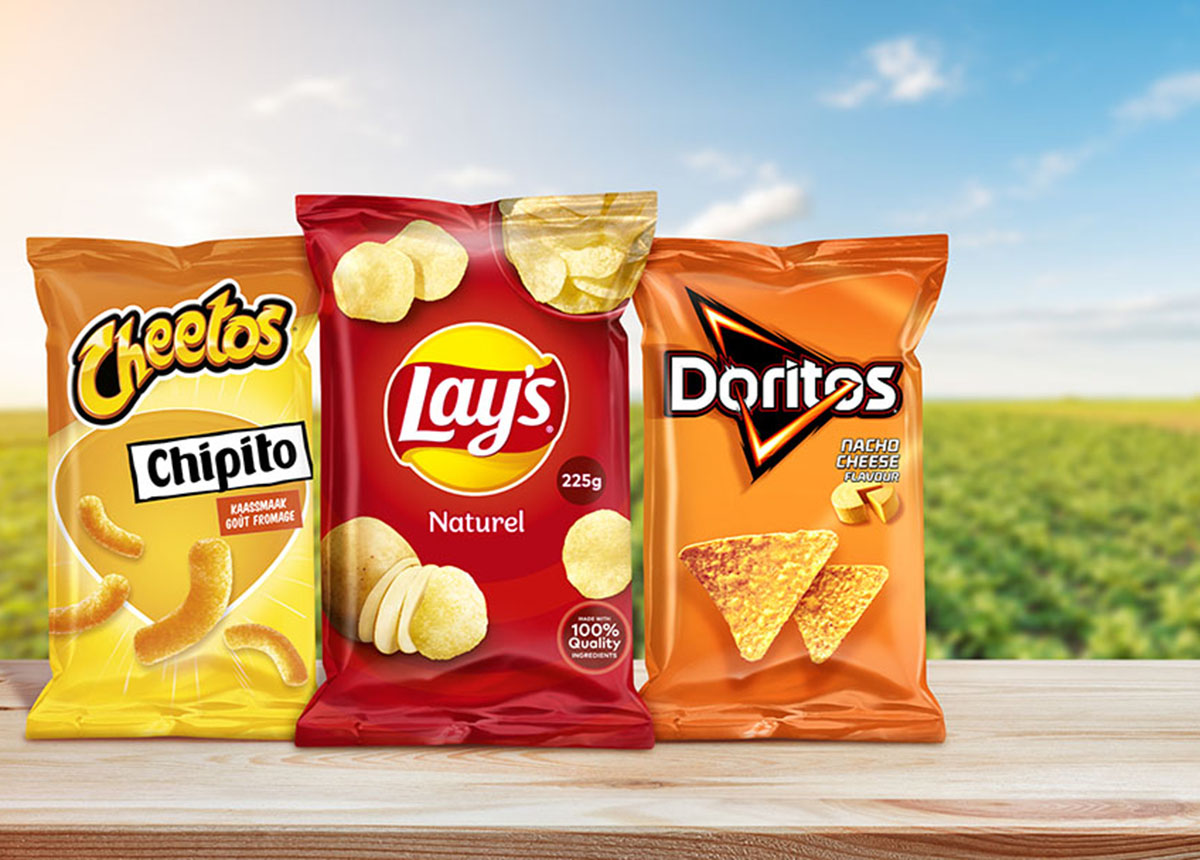
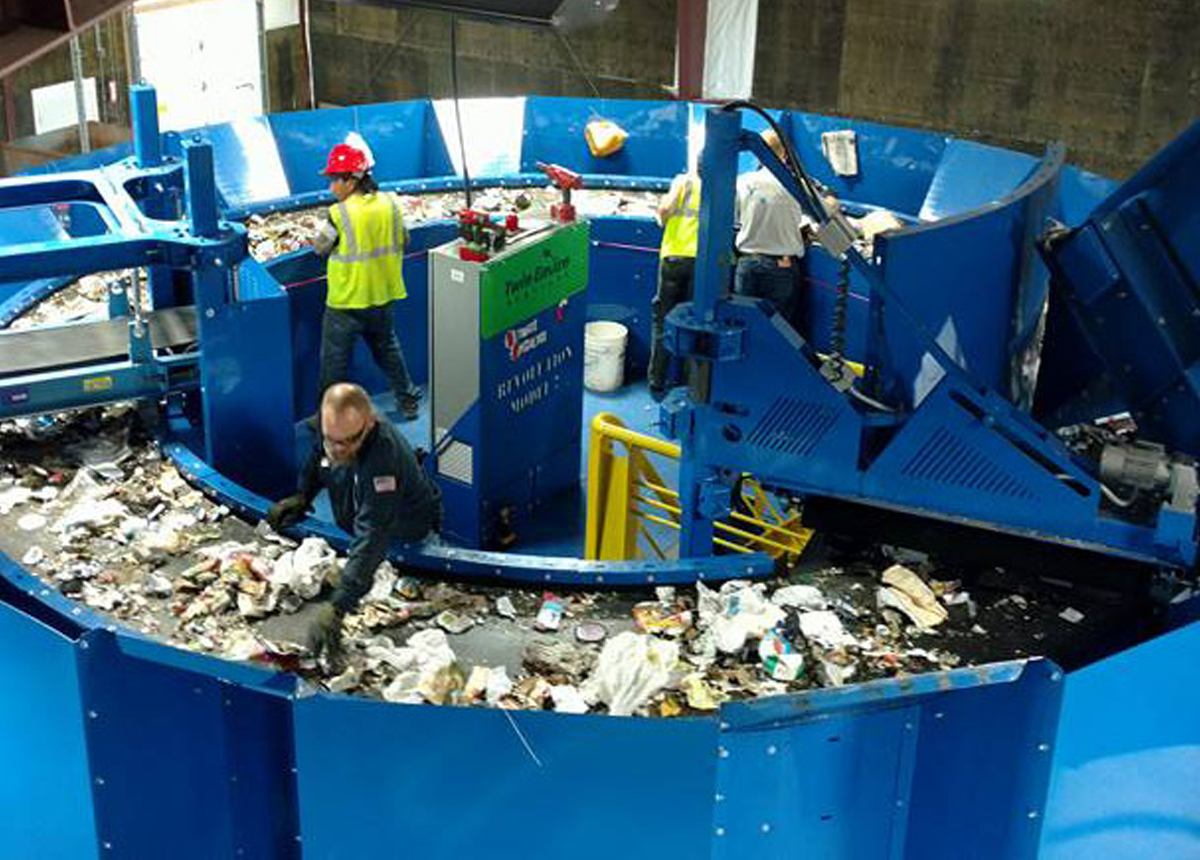
420121cdc23b4935806989053f436f56.png)
